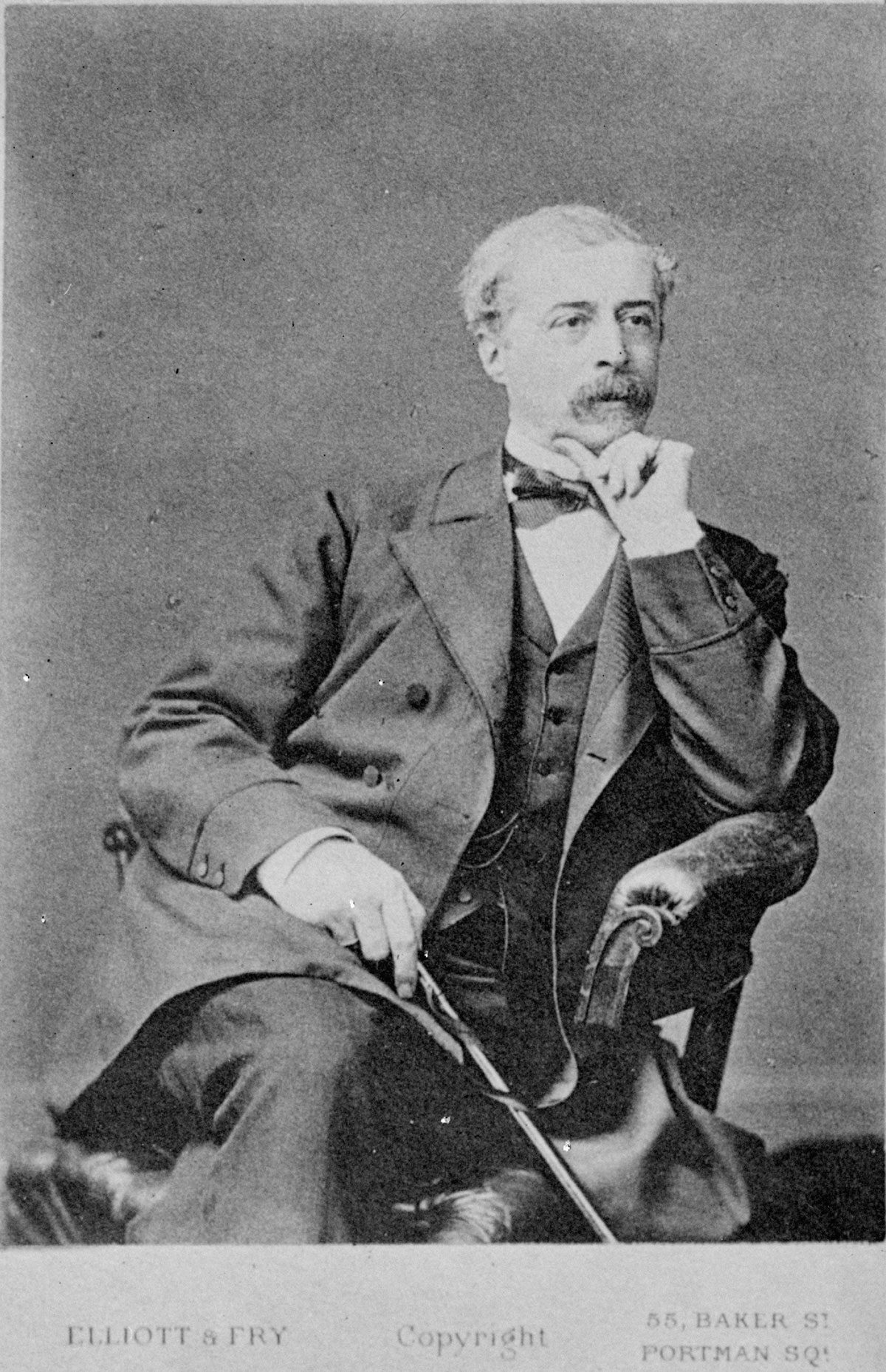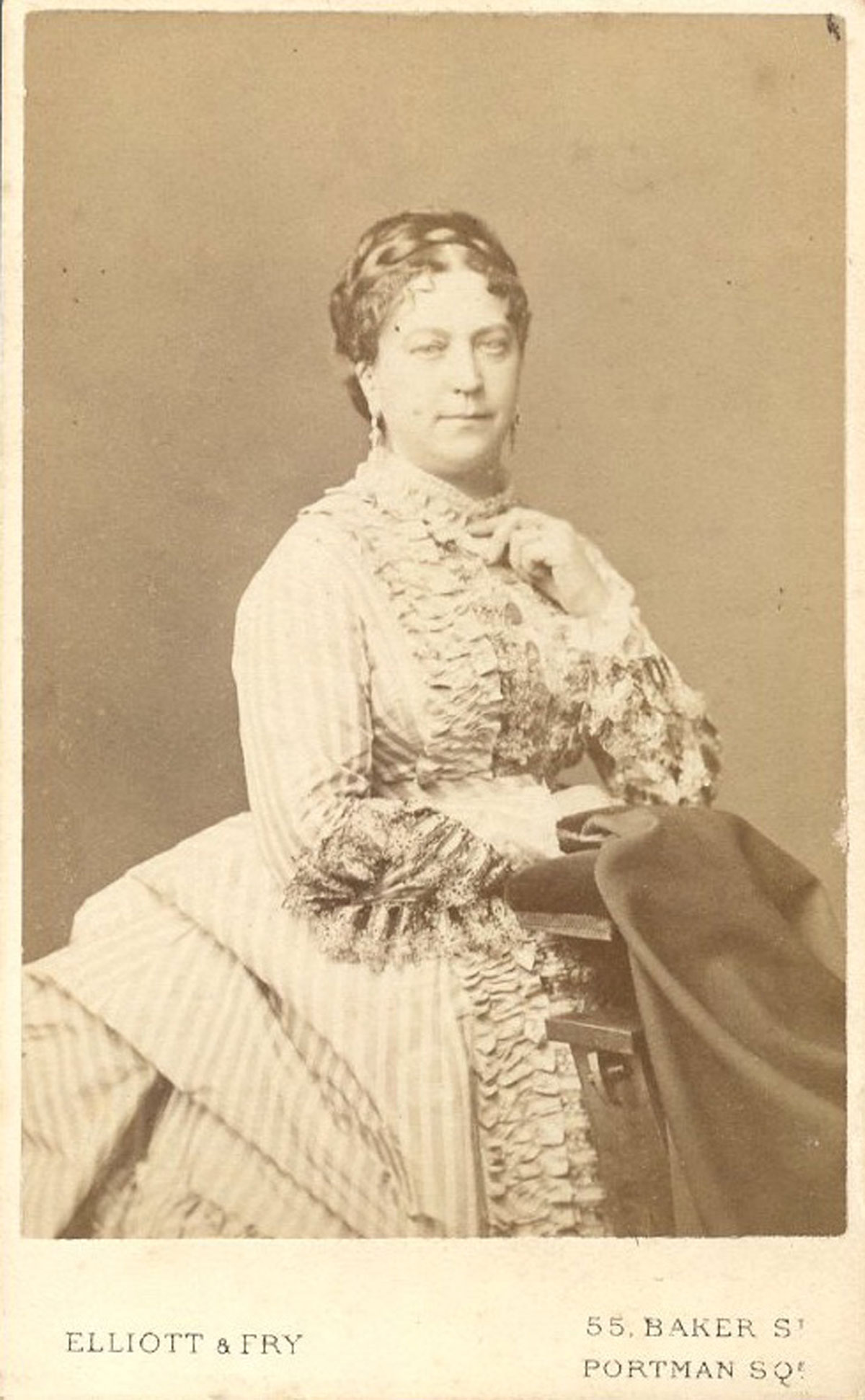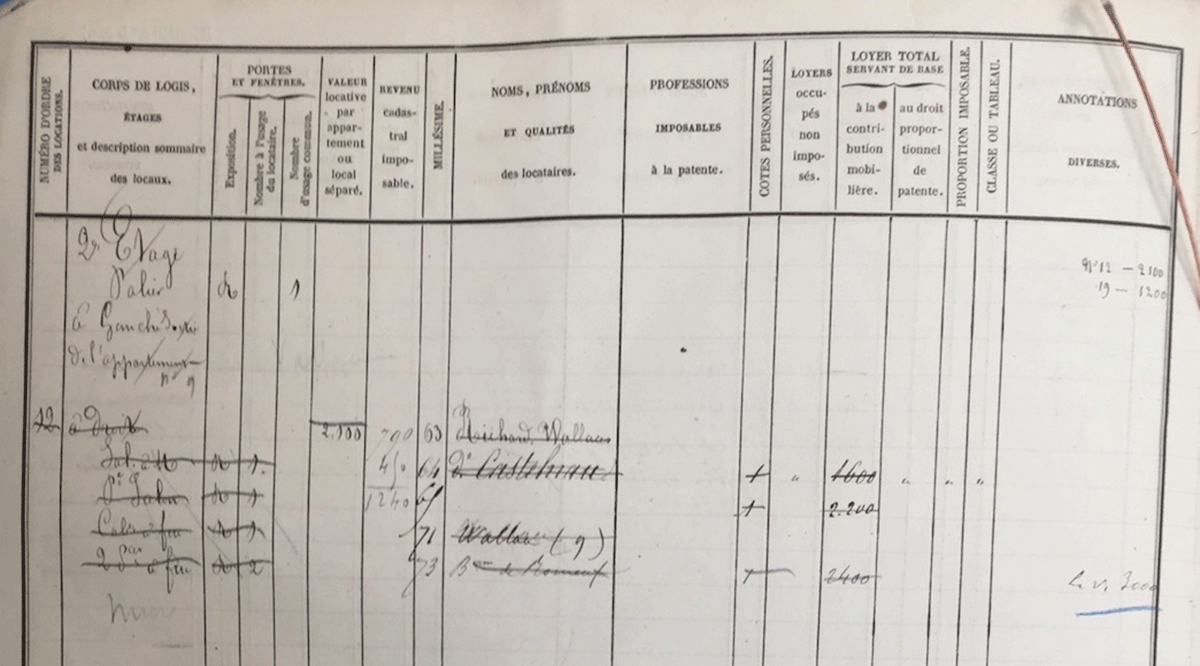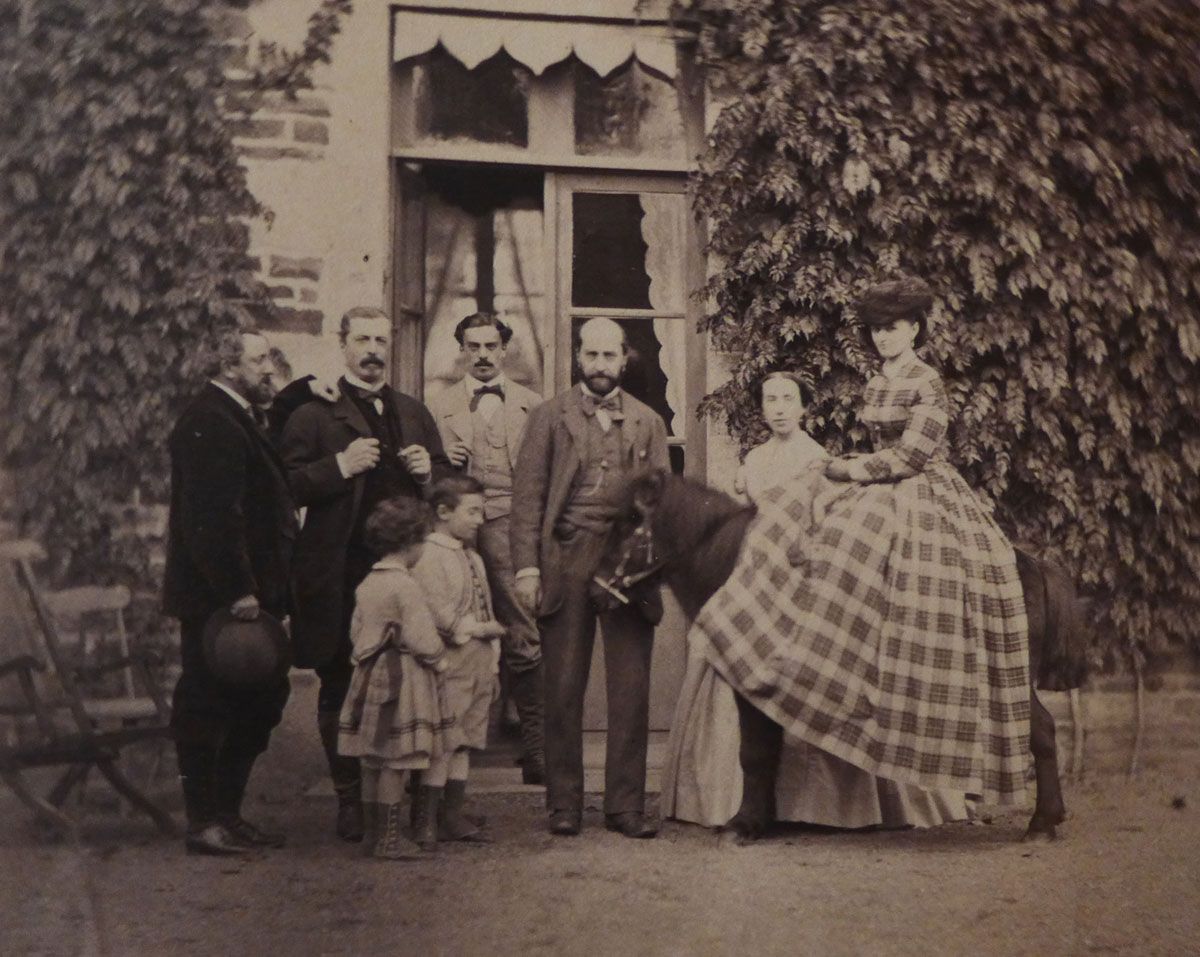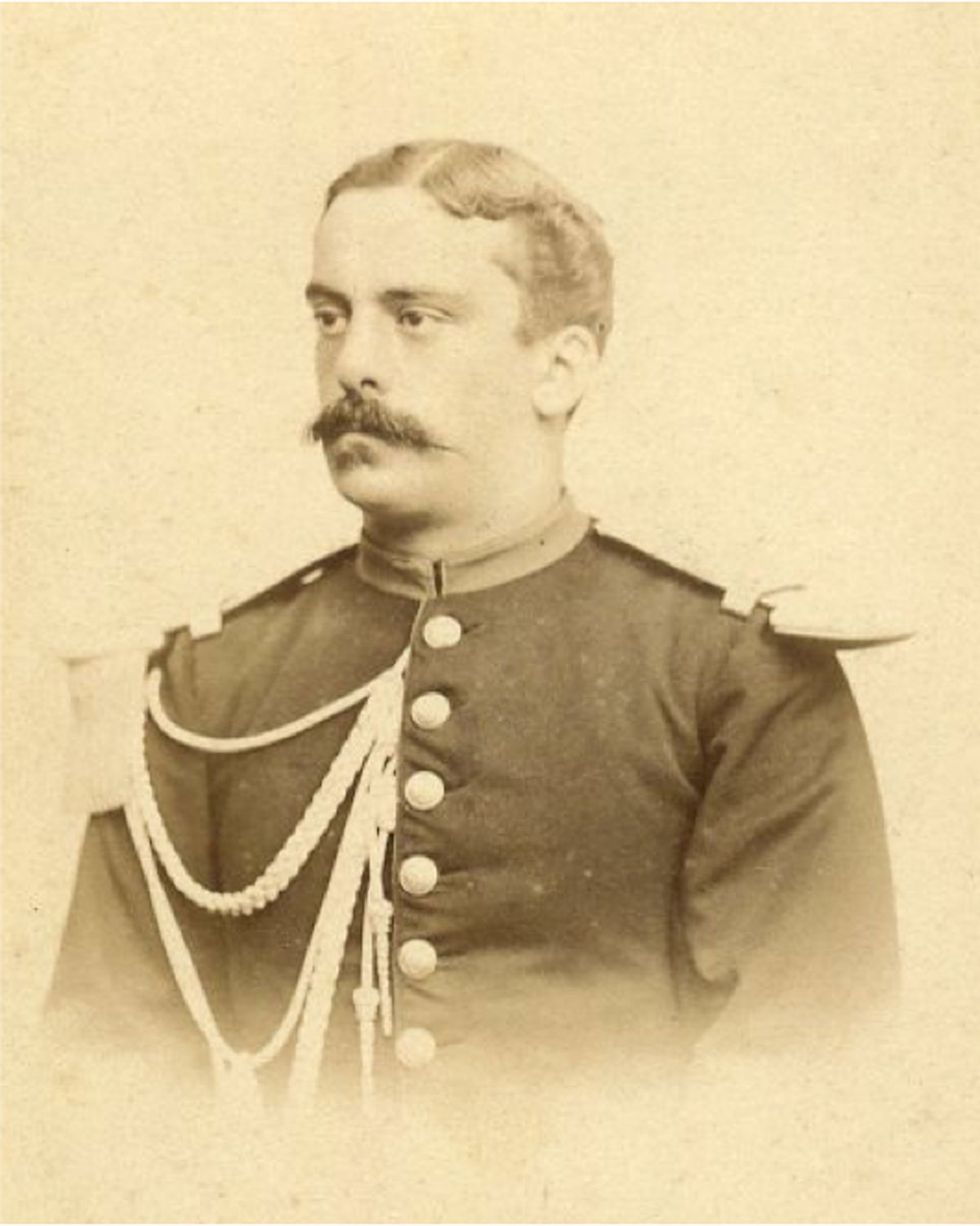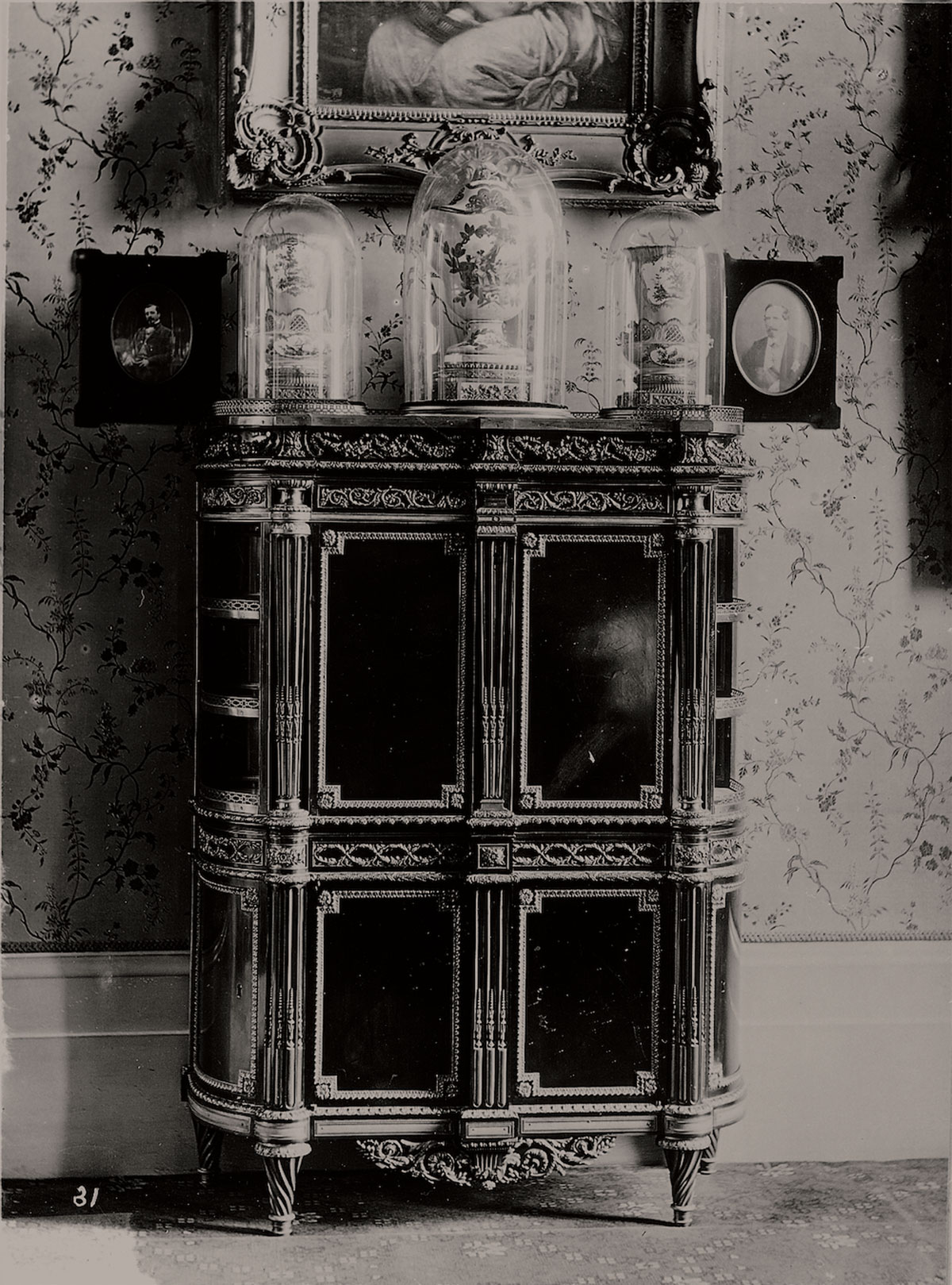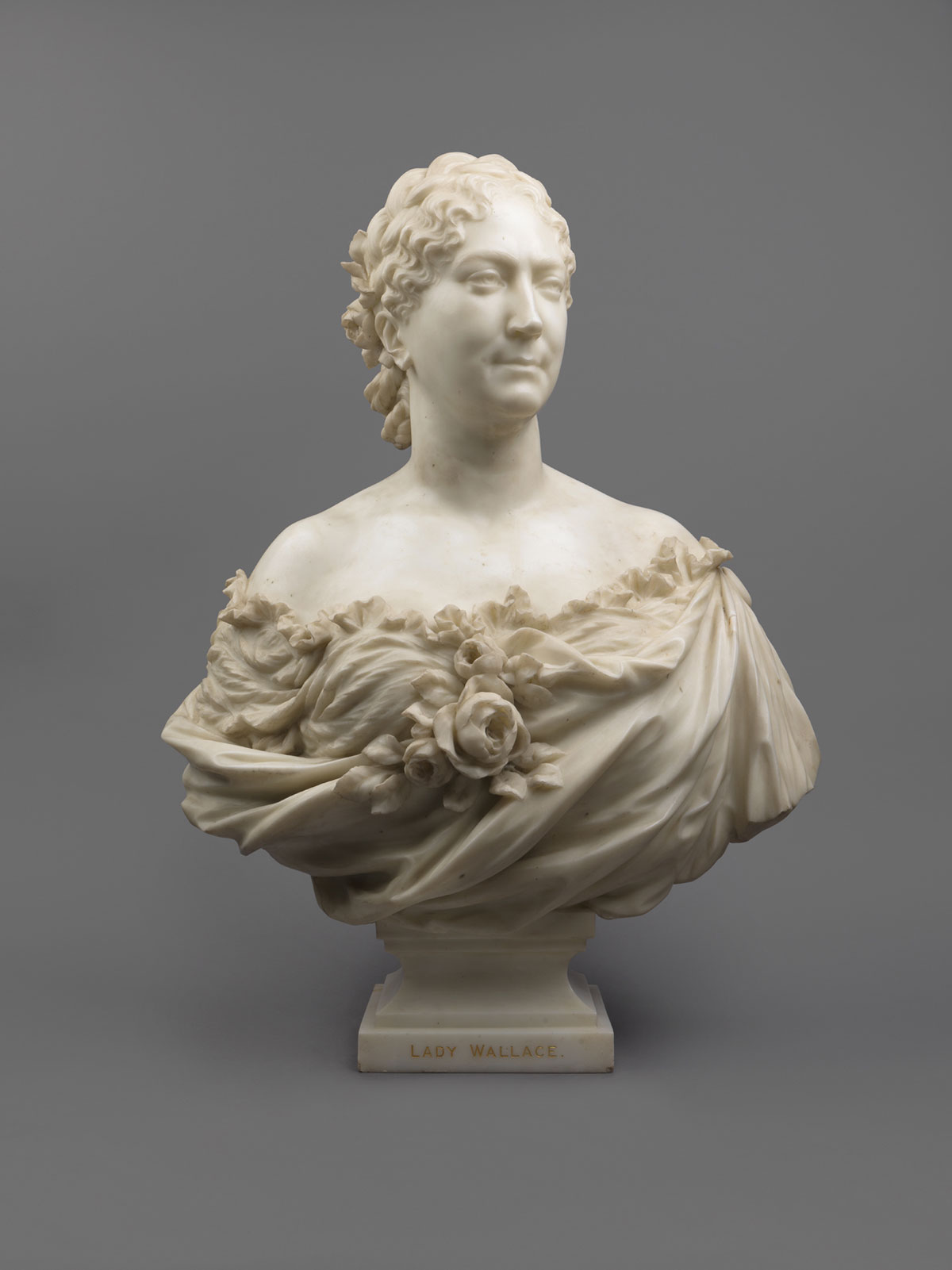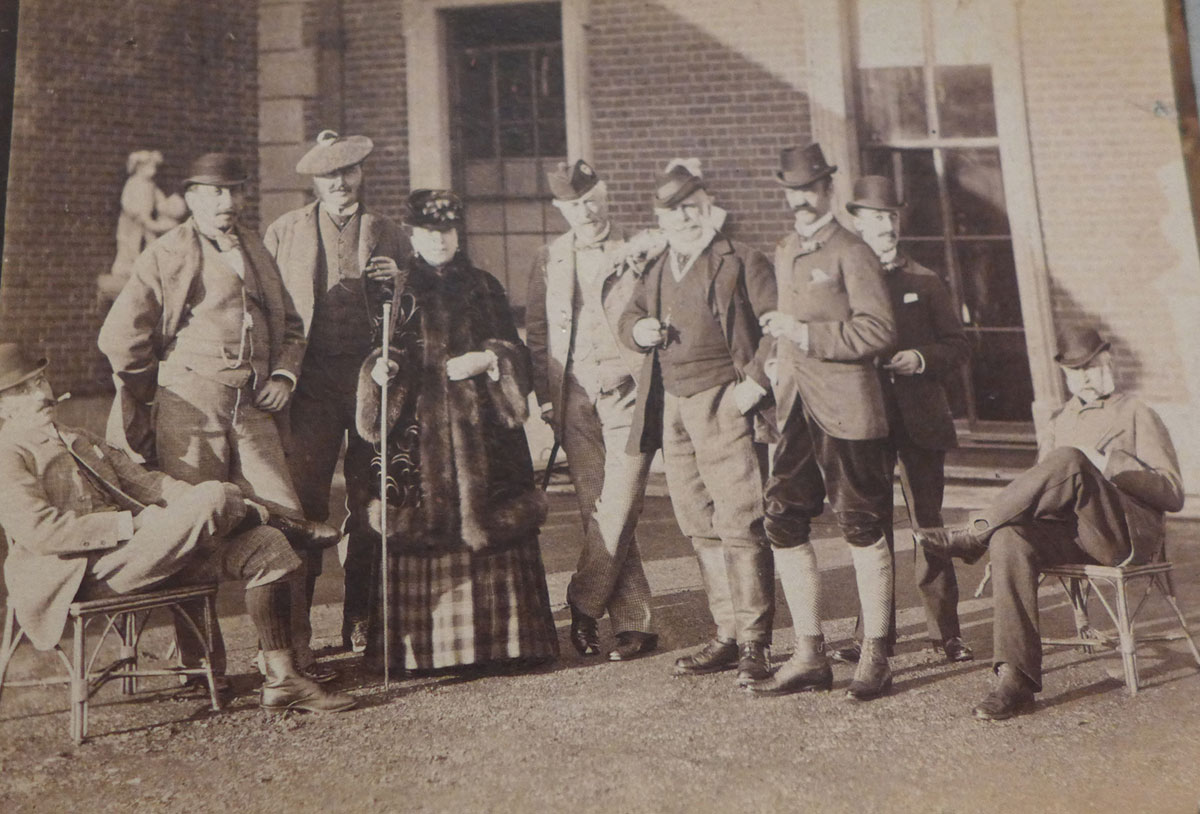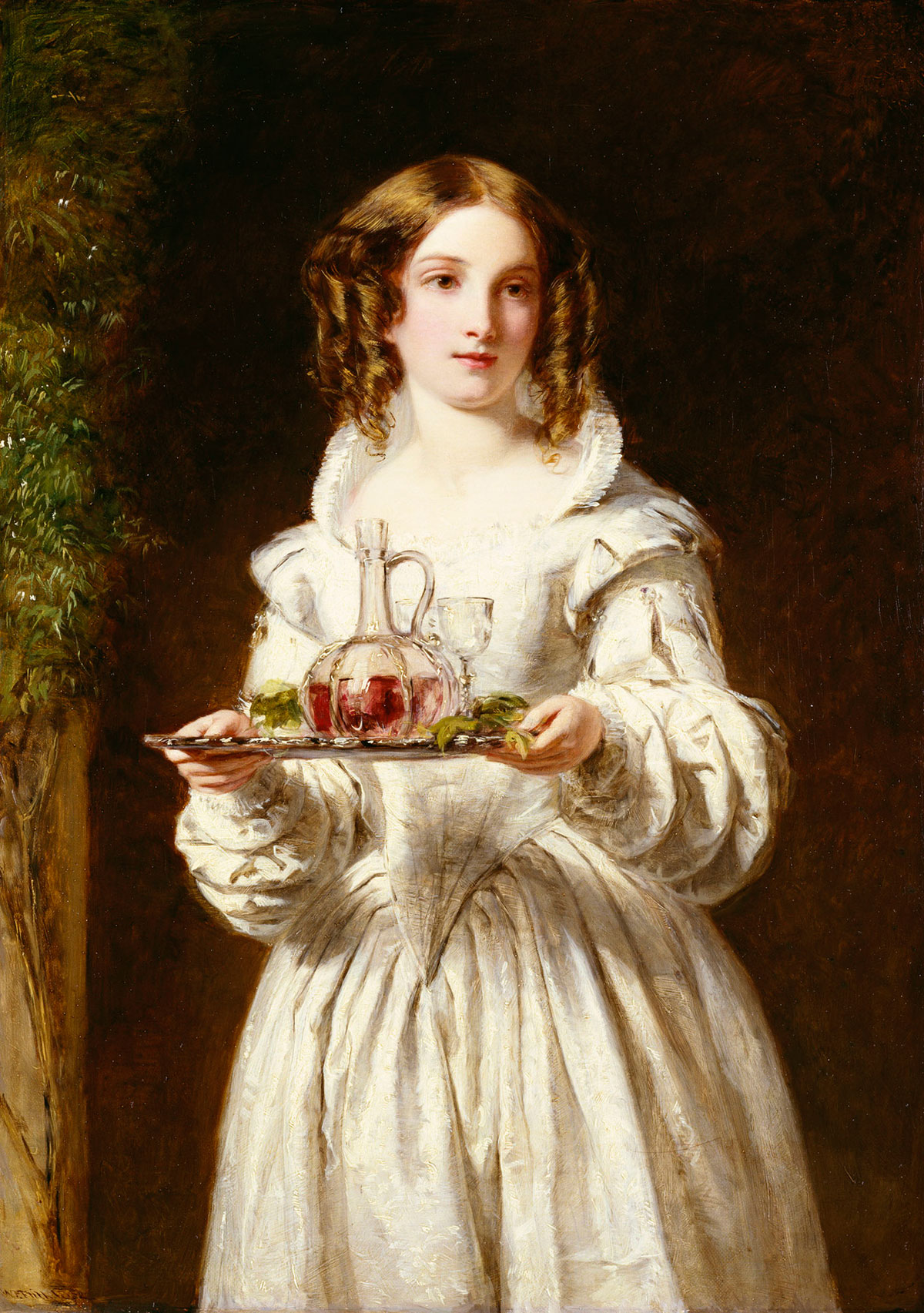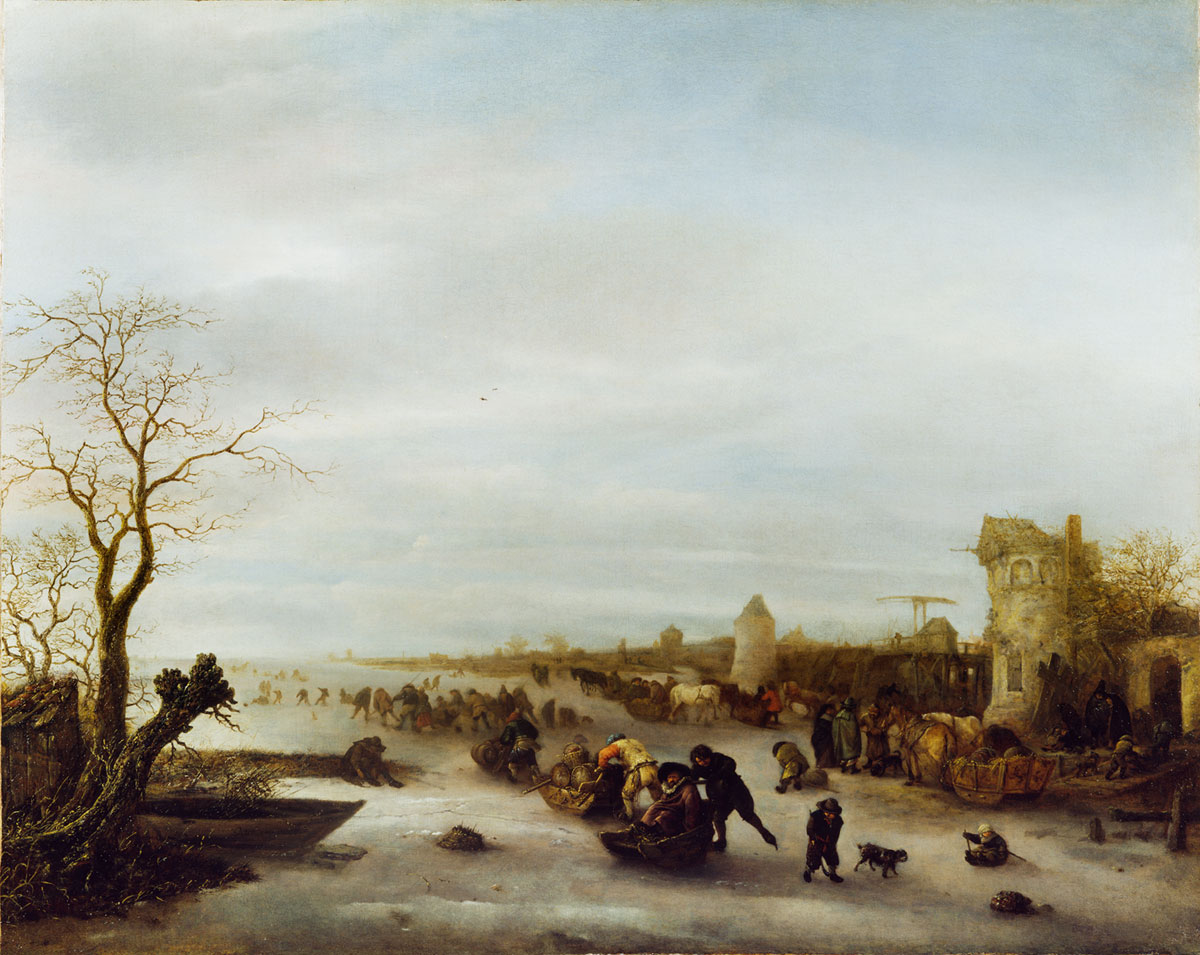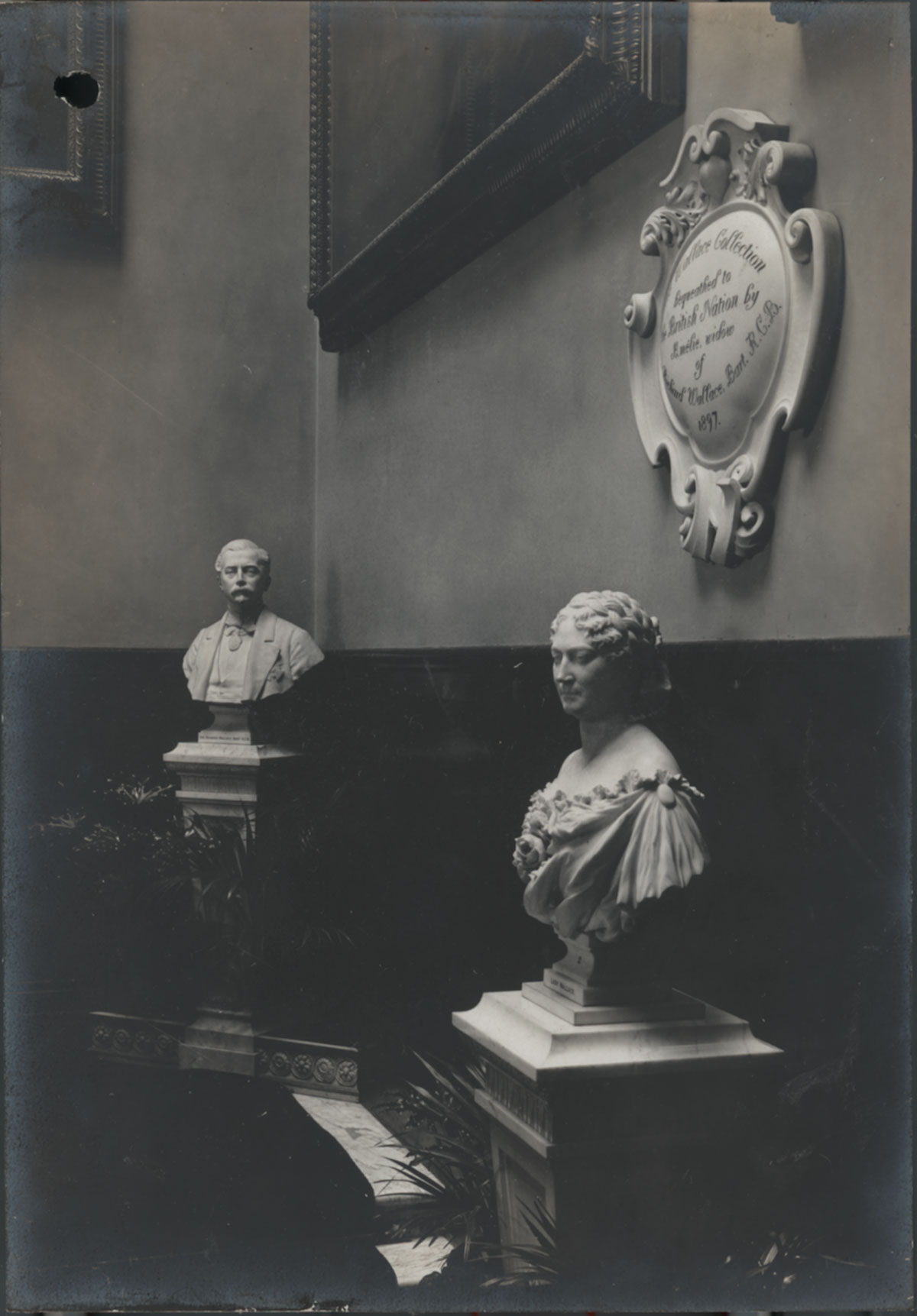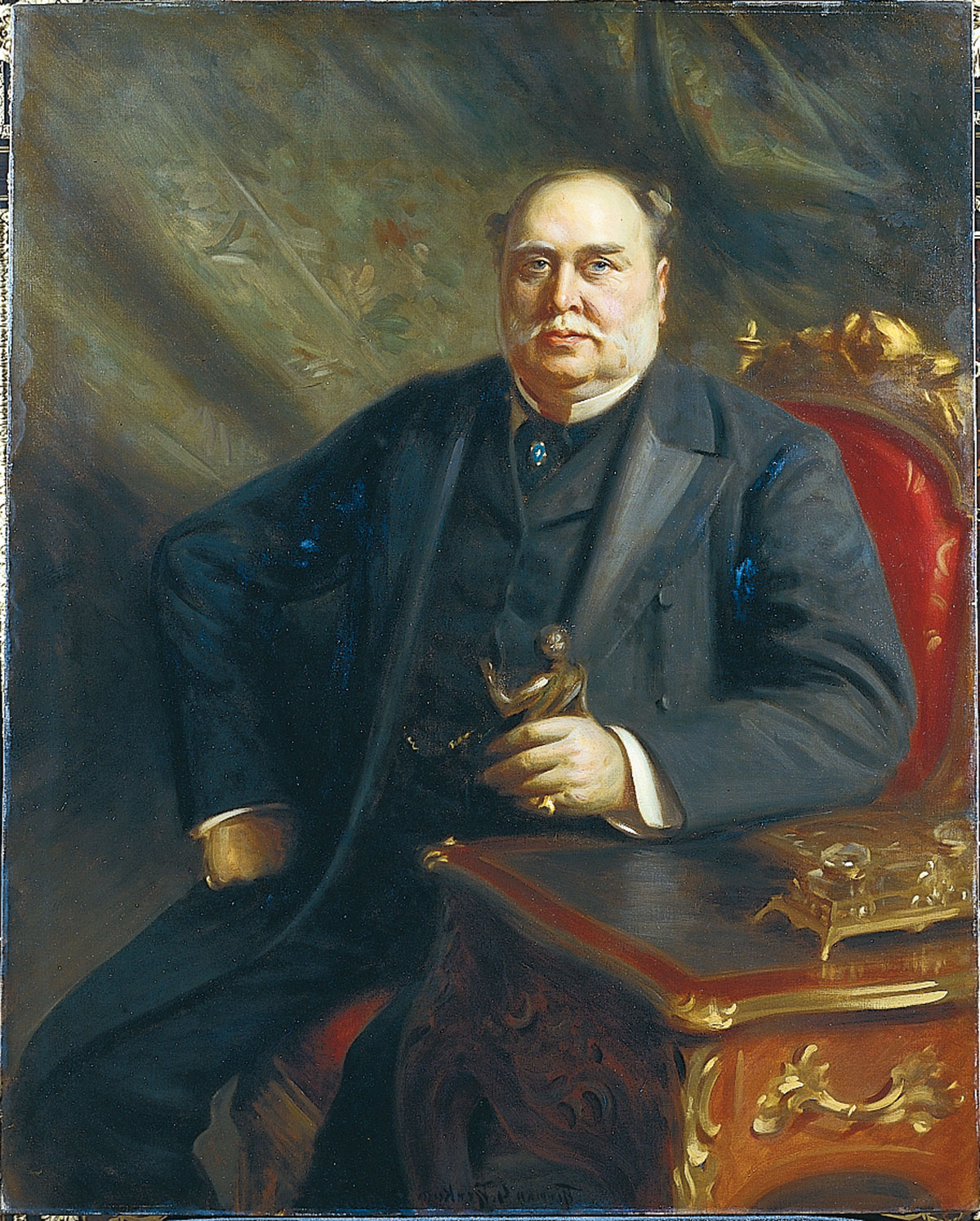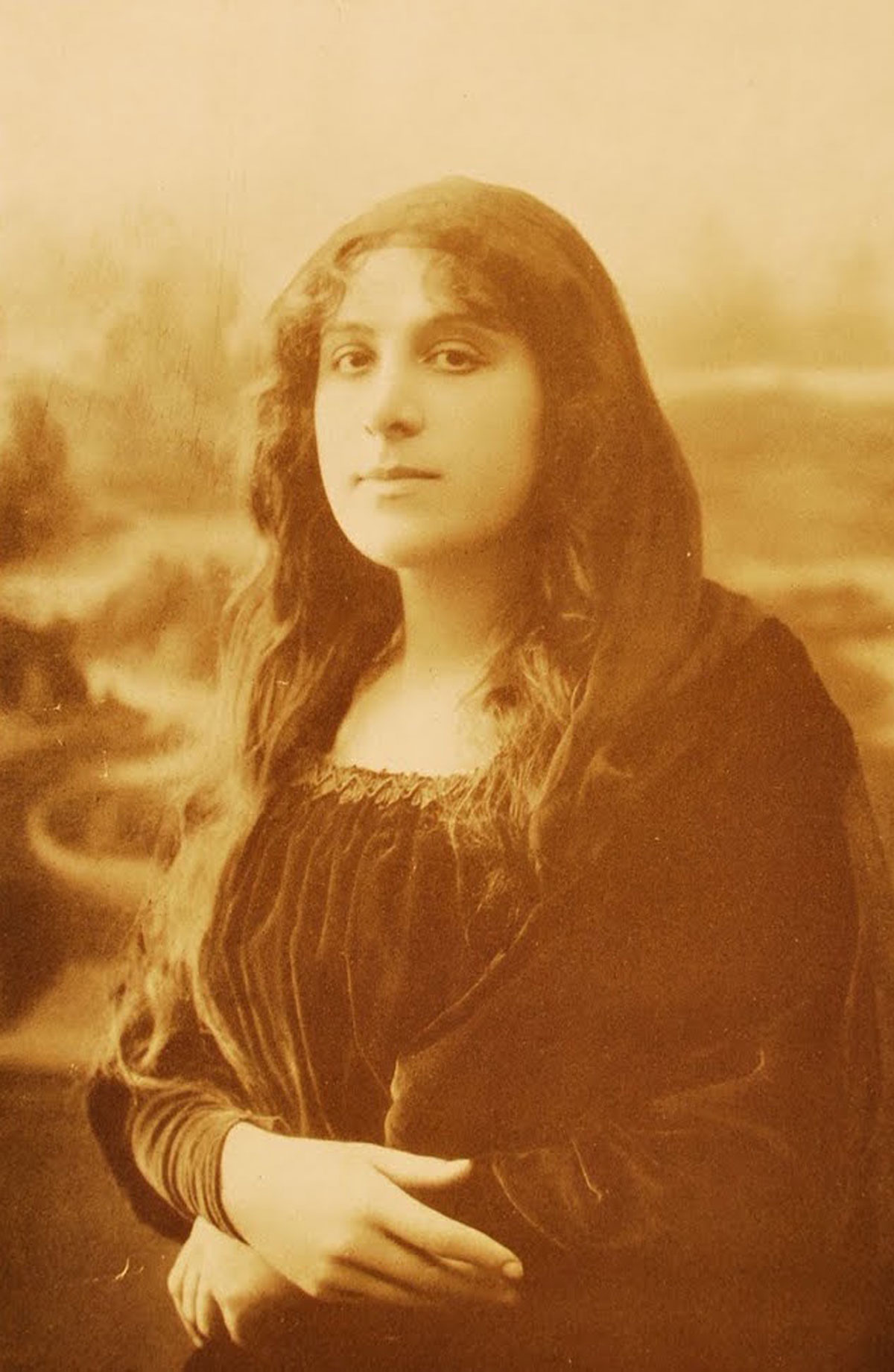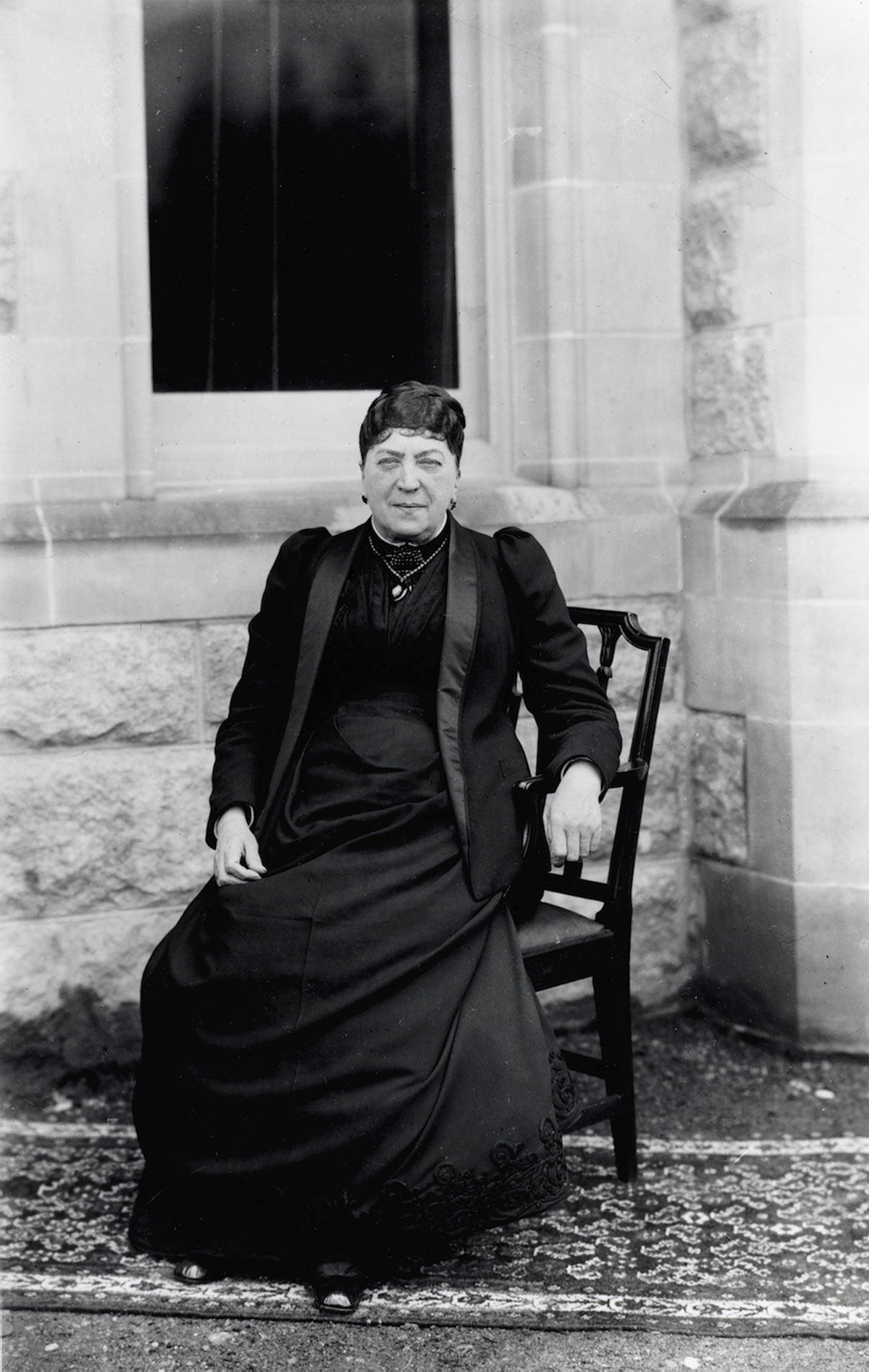During the formal opening of the Wallace Collection at Hertford House in central London on 22 June 1900, Lord Rosebery, chairman of trustees, described the collection as ‘the greatest gift, I believe, that has ever been made by an individual to our country’.1 Not only was the gift itself exceptional, but the ‘individual’ who gave it was also remarkable. For the Wallace Collection was bequeathed to the British nation by Lady Wallace, the widow of Sir Richard Wallace, an Englishman and the likely illegitimate son of Richard Seymour-Conway, 4th Marquess of Hertford. Lady Wallace was a Frenchwoman of humble birth. She had married Richard Wallace in Paris, their home city, in February 1871, when their own illegitimate son was thirty years old, and six months after Wallace had unexpectedly inherited from Lord Hertford great wealth and a fabulous art collection. In August 1871 Queen Victoria awarded Wallace a baronetcy for his philanthropy. Several months later Sir Richard and Lady Wallace moved to England and made Hertford House, in Manchester Square, their main residence. Lady Wallace lived in England for the last twenty-five years of her life, remaining at Hertford House after Sir Richard’s death in 1890 and dying there herself in 1897 (Figs. 1, 2).
Rarely, for a woman of her time, Lady Wallace’s life spanned the social and cultural divide between her French working-class origins and her privileged status in Britain. She spoke little English and was not herself a collector. She inspired both deep disparagement and great admiration. Two examples illustrate this. Baron Ferdinand de Rothschild, whose assessment of Lady Wallace was imbued with snobbery, observed of her effect on Sir Richard’s integration into British society that ‘she dragged him down to her level, clogged his whole future, and marred all his prospects’. By contrast, Lord Esher recalled ‘a very refined, shy and excellent lady’.2 There are no known documents in her own hand. In short, Lady Wallace is an enigma.
The astounding collection that Lady Wallace bequeathed to the British nation on her death had been formed by the first four marquesses of Hertford and Sir Richard Wallace between the mid-eighteenth and the late nineteenth centuries. As the 4th marquess had not married and had no legitimate heirs, following his death on 24 August 1870, his title and entailed estate, which included Ragley Hall in Warwickshire, the Sudbourne estate in Suffolk, the lease of Hertford House, and some entailed works of art, went to a cousin, Francis Seymour, who became 5th Marquess of Hertford. Wallace’s inheritance of Lord Hertford’s unentailed assets included a superb art collection, properties in Paris, and, after litigation, a large estate in the north of Ireland. Wallace purchased the Sudbourne estate and took over the lease of Hertford House from the 5th Marquess of Hertford. Lady Wallace’s bequest to the nation comprised the works of art ‘on the ground and first floors and in the galleries at Hertford House’.3 It excluded the many works of art in the Wallaces’ properties in Paris and Ireland, which Lady Wallace bequeathed to her residuary legatee, John Murray Scott. The Wallace Collection comprises more than five thousand works of art and is internationally renowned — perhaps unrivalled — for its exquisite eighteenth-century French paintings, furniture, Sèvres porcelain, and gold boxes. But it also comprises exceptional holdings of old master paintings, European arms and armour, and medieval and Renaissance works of art.
So, who was Lady Wallace and what were the circumstances that led her to leave the Wallace Collection to the nation? More than a hundred years after she made her bequest, why has she remained a relatively blank page, shrouded in negativity? In the light of her extraordinary magnanimity, why has history consigned her to its shadows? This article will attempt to unmask the enigma, answer these questions, and assess the wider legacy of Lady Wallace’s bequest.4
From Mlle Castelnau to Mrs Wallace
Lady Wallace was born in Paris on 15 March 1819 to unmarried parents, Bernard Castelnau, a 36-year-old homme de confiance (factotum), and Sophie Elisabeth Knolt (or Knoth), an ouvrière en linge (linen maid). Her name at birth was Julie Amélie Charlotte Castelnau. Nothing is known of her education. By 1839, aged nineteen or twenty, she had met a young Englishman called Richard Jackson (later Richard Wallace). Jackson had been born in London to one Agnes Jackson on 26 July 1818. His mother had left him in Paris in the care of a nurse in 1825 and from the age of seven he had been brought up there in the household of Maria Fagnani, 3rd Marchioness of Hertford, the estranged wife of the 3rd marquess. It has traditionally been stated that Richard met Julie when she was working as an assistant in a perfume shop in the Passage du Saumon, a fashionable shopping district frequented by smart young men; it has also been said that she was a dressmaker. She may have practised both professions. On 29 August 1840 Julie gave birth to a son, whose father was Richard Jackson, and who seems not to have lived with his mistress and son. On 21 April 1842 Jackson was baptized as Richard Wallace, the name that he would continue to use for the rest of his life. Could his motivation for baptism have been that he was contemplating marriage to Julie and would need a certificate of baptism to marry in a church? (Higgott, pp. 28–31, 323).
As a result of the February Revolution of 1848, which saw the abdication of Louis-Philippe, Richard Wallace took up residence in a suite in the Hôtel des Bains in Boulogne-sur-Mer with the 3rd Marchioness of Hertford and her younger son, Henry Seymour. They resided there until 1855, when they returned to Paris. All we know of Julie and her son from this period is that on 18 August 1849, aged nearly nine, the child was baptized Georges Henry Edmond Castelnau. He and his mother were living at 44 rue de Provence, close to rue Taitbout, rue Laffitte, and the boulevard des Italiens, the streets where, between 1816 and 1872, the Hertfords and Wallace created a small commercial and residential property empire and where they also resided. From childhood until at least 1871 Wallace’s residential address in Paris was 1–3 rue Taitbout, which was owned by the 3rd Marchioness of Hertford (d.1856) and also the home of Lord Henry Seymour (d.1859). The Paris residence of her older son, Richard Seymour-Conway, was in the adjacent street, at 2 rue Laffitte, the major Parisian street for picture dealers. The Marchioness of Hertford was knowledgeable about art and her sons became enthusiastic and discerning collectors (Higgott, pp. 323, 366–67).
On becoming 4th Marquess of Hertford in 1842 Richard Seymour-Conway dedicated his life to collecting works of art of outstanding quality — especially old master paintings and eighteenth-century French paintings and decorative arts — few being able to compete with him in the art market. From at least 1843 Richard Wallace acted as Lord Hertford’s art agent at auctions in Paris and abroad. From the late 1830s Wallace had been forming his own collection, which was to become distinguished before debt obliged him to sell it in 1857. It reflected his own taste for medieval and Renaissance works of art and nineteenth-century French pictures.
After his return to Paris from Boulogne-sur-Mer in 1855 there is some scant circumstantial evidence of Wallace’s interaction with Julie and their son Georges. According to an account written shortly after Lady Wallace’s death, she and Wallace had lived together for twenty years before their marriage in 1871. While there is no conclusive evidence to support this, Wallace appears to have been in close contact with Julie and Georges in the early 1860s. By 1861 Julie had moved to an apartment at 1–3 rue Taitbout — the property by now belonging to Lord Hertford — where Wallace also resided. She is also recorded as residing there in 1863 and 1864 (Fig. 3) (Higgott, pp. 326–27, 414, n. 19). Bernard Falk wrote in ‘Old Q’s’ Daughter that Julie and Georges lived at 29 boulevard des Italiens; the property was owned by Wallace, who rented out rooms there from the mid-1850s.5 Yet Julie seems not to have been of the party when Richard and Georges stayed with friends in 1862 or 1863, since she is not included among the people identified in photographs taken during the visit (Fig. 4).
Document recording Richard Wallace as the leaseholder of an apartment on the second floor of 1–3 rue Taitbout in 1863 and Dame Castelnau as the leaseholder of the same apartment in 1864. Archives de Paris, Calepin des propriétés bâties (Locataires), côte D.1 P4 1114. Photograph courtesy of Olivier Hurstel.
Wallace seems not to have been faithful to Julie. There has been speculation that he had a relationship with Julie Anne Peccot and was the father of her son Claude-Antoine, who was born at Auteuil on 27 April 1856 and died aged twenty in 1876.6 In about 1860 Wallace is believed to have had an affair with the bohemian literary hostess Apollonie Sabatier.7
In February 1871, a few months after Wallace had come into his inheritance, and following France’s disastrous defeat in the Franco-Prussian War, in which Georges Castelnau had served under General Vinoy (Fig. 5), Julie and Georges’s status changed dramatically. For on 11 February Wallace officially recognized his 30-year-old son, whose name is not recorded in the legal document as Georges Henry Edmond Castelnau, but as Edmond Richard Wallace. And a few days later, on 15 February, Julie and Richard married at the mairie of the 9th arrondissement in Paris, giving their address as 3 rue Taitbout. Julie’s given names on the couple’s marriage certificate are recorded as Julie Amélie Charlotte, but by 1880 she had adopted Amélie as her first name of choice.8
It has often been stated that the Wallaces did not marry during Lord Hertford’s lifetime because he disapproved of Julie Castelnau. Although the reason for their late marriage will probably never be known, available evidence suggests that Lord Hertford’s disapproval may not have been the reason. Not only was Julie Castelnau living at 1–3 rue Taitbout in the early 1860s, when it was owned by Lord Hertford, but a photograph of Hertford by Étienne Carjat was prominently displayed, balancing a photograph of Sir Richard, in the boudoir at Hertford House, a room closely associated with Lady Wallace, until her death (Fig. 6). The view that Lord Hertford disapproved of Julie Castelnau has not been universally held in the twentieth century.9
Sir Richard’s legal recognition of his son, and the Wallaces’ marriage a few days later, heralded the beginning of a new life for Julie. On their marriage certificate her parents are described as deceased, and contrary to their status at the time of her birth, married. Her father has traditionally been described as a French officer, information perhaps gleaned from Julie, which gave him higher status than that of a factotum. Perhaps she wanted to improve her social standing, but it is also possible that her parents’ circumstances changed.10
The charity with which Wallace was most closely involved at this time was the British Charitable Fund, which assists British people resident in France who find themselves in difficult circumstances. The charity was sorely challenged by the number of requests for help it was receiving and Wallace was both a very active committee member and a generous donor. A photograph of the charity’s committee, taken a few weeks after the Wallaces’ marriage, is inscribed ‘Homage to Mrs Wallace 10 March 1871’.11
Becoming Lady Wallace
The year 1871 continued a momentous one for Julie. Her family now had official recognition and she had a public profile due to her husband’s celebrity, resulting from his renowned philanthropy to the city of Paris during the siege and war of 1870–71, and the dramatic circumstances around his inheritance. Julie was thrust further into the limelight after Wallace was awarded a baronetcy. In the course of only eight months she had gone from being a woman of dubious social status and no public interest to the wife of an English baronet who was one of the most celebrated men of the day. Her changed status was underscored in France the following year, when Charles-Auguste Lebourg exhibited his marble bust of her at the Paris Salon (no. 1749) (Fig. 7).
By the autumn of 1871 Sir Richard and Lady Wallace had decided to move to England, taking many of the works of art in their Paris residences with them. The considerably greater political stability of Victorian England must have had much appeal for Wallace, whose status in British society was rapidly enhanced by benefactions from his collection. On 25 October 1871 he presented to the National Gallery Gerard ter Borch’s The Ratification of the Treaty of Münster, for which the gallery had competed unsuccessfully at auction against an agent representing Lord Hertford.
Early in 1872 Wallace embarked on what was to be a generous and regular activity: lending to exhibitions in Great Britain, Ireland, and France, sometimes to raise funds for philanthropic causes, such as assisting the homeless and refugees, or for the educational benefit of local communities. The exhibition that garnered him huge popularity soon after the Wallaces’ move to England was his loan of over two thousand works of art to form a single-lender opening exhibition at the Bethnal Green Museum, the first branch museum of the South Kensington Museum, situated in an underprivileged area of London. Sir Richard’s loan provided him with a home for many of his treasures between June 1872 and May 1875 while Hertford House was extended to accommodate his household and expanding collection. At the Bethnal Green opening on 24 June 1872 Sir Richard had the honour of guiding the Prince and Princess of Wales round his collection.12 Sir Richard rapidly received and responded favourably to invitations to serve on a range of prestigious committees. He also served as Conservative MP for Lisburn, the seat of his Irish estate, from 1873 until 1885.
In May 1876 Sir Richard and Lady Wallace began to receive guests at Hertford House and the first visitors signed the Hertford House visitors’ book. The book reflects the fascination that the collection held for a wide range of visitors, from British and foreign royalty and aristocracy to female activists and pioneers.13
Being Lady Wallace: hostess and benefactress
This dramatic change in circumstances must have presented the newly created Lady Wallace with enormous challenges. Swept into life in a foreign country, and unpractised in speaking English although married to a bilingual Englishman, she had rapidly to acclimatize to a role in the public eye, not only as the wife of a major landowner in Ireland and Suffolk, but also as the spouse of a philanthropist and art connoisseur mixing in the highest echelons of society.
Perhaps inevitably, Lady Wallace was to remain an outsider in British society, the circumstances of her son’s birth and her reluctance to speak English being significant disadvantages. In 1875, when Prime Minister Disraeli tried to secure a new baronetcy for Wallace, with remainder to Edmond, Queen Victoria declined on the grounds that granting a revision to an illegitimate son would set an ill-advised precedent. Since Lady Wallace’s closest companions, Sir Richard and his private secretary, John Murray Scott, spoke fluent French, it is likely that she usually conversed with them in her native tongue. Her reluctance to speak English was a serious impediment to her assimilation in the social milieu in which Sir Richard now circulated, leading contemporaries to make detrimental comments about her and the time spent in her company. Recalling a dinner in November 1872, when he was a guest at Sudbourne, the 1st Earl of Cranbrook wrote, ‘Lady Wallace speaks only French, and I took her in, to my dismay, and stumbled through some very bad language.’ During the twentieth century her reputation suffered from the publication of such accounts, and this, taken together with our general lack of information, has undoubtedly contributed to the negative perception of her since at least 1937, when Bernard Falk published ‘Old Q’s’ Daughter. Taken together with the bias of evaluating women, to a greater degree than men, on their physical appearance, negative comments on her personality, and social and cultural snobbery, Lady Wallace’s reputation has fared badly, and this has inevitably informed the way in which she has been perceived within the Wallace Collection (see ‘The afterlife of Lady Wallace’ below).14
After moving to England, Lady Wallace evidently sought to model herself on the precedents set by the wives of the British aristocracy and nobility. The responsibilities these precedents engendered were multifaceted. At Hertford House, and at Sudbourne, where the Wallaces hosted residential winter shooting parties, Lady Wallace was the hostess (Fig. 8). Invitations to ‘At Homes’ at Hertford House went out in her name, adhering to contemporary etiquette. The Ipswich Journal (28 June 1883) reported of a party given on 21 June: ‘Lady Wallace gave one of her delightful parties at Hertford House and threw open the galleries of the most magnificent house in London. The Engineers played in the garden-court, and the Blue Hungarians in the great gallery.’ At Sudbourne shooting parties she would join the sportsmen during breaks, as depicted by the French artist Alfred Decaen (1820–1902) in paintings that now belong to the New Orford Town Trust. The Prince of Wales was among the guests in 1879. (For reproductions of the paintings by Decaen, see Higgott, pp. 148–49.)
Another arena in which Lady Wallace fulfilled a traditional role befitting her status in English society was her patronage of fundraising events in aid of worthy causes, such as bazaars, which were often organized by women. Women’s philanthropy was traditionally centred on the domestic sphere and supporting families of the poor.15 Some of the causes supported by Lady Wallace related to Wallace’s estates and complemented his charitable activities. His estate in the north of Ireland was close to Belfast. Among a number of bazaars of which she was a patron, sometimes together with Sir Richard, were those to raise funds for causes affecting the local population living on or in the vicinity of his Irish estate, such as those in aid of the Ragged School in Belfast in 1873, the Belfast Hospital for Sick Children in 1877, or the Workshops for Industrious Blind, held in Belfast in 1878. In 1876 Wallace lent pictures to the ‘Industrial Exhibition and Bazaar’ held in Belfast to raise funds for the Belfast Working Men’s Institute and Temperance Hall. The Duke of Abercorn, Lord Lieutenant of Ireland, was the main patron of the event. The bazaar was organized under the patronage of the Duchess of Abercorn and Lady Wallace. Unusually, in 1879 Lady Wallace was on a committee, the General Committee of the Duchess of Marlborough’s Fund for the Relief of Distress in Ireland, formed to relieve ‘the very severe distress at present existing in the west of Ireland’. Her general absence from women’s philanthropic committees may have been due to her reluctance to speak English and her shyness, which was remarked upon by Lord Esher. Lady Wallace took on other philanthropic duties typical of estate owners’ wives, such as donating to an orphans’ home in Suffolk and to a poor Irish tenant who had given birth to triplets. In Suffolk she distributed gifts to children at the Sudbourne festival known as the ‘Orford Christmas Tree’, and in 1877 and 1880 she presented trophies at the Orford Regatta. She also worked in tandem with Sir Richard on some projects, notably presenting furnishings to All Saints Church in Sudbourne when Sir Richard undertook its renovation between 1879 and 1882, and a silver liturgical set to St George’s Anglican Church in Paris in 1886, during the construction of a new building for the church under Sir Richard’s chairmanship and patronage. Lady Wallace’s patronage extended beyond her husband’s estates. For example, she was one of the patronesses of a large fete and bazaar held at a ‘Health Exhibition’ for the benefit of London hospitals in July 1884.16 While Lady Wallace was actively engaged in fulfilling society’s expectations of her as the wife of an English baronet, she was conservative in the causes that she supported. Hertford House was in close proximity to individuals and organizations that championed increasing initiatives to further women’s independence, but there is no evidence of her involvement with these local causes and initiatives.17
Perhaps surprisingly, since Lady Wallace is not known to have been a collector in her own right, she lent to two exhibitions alongside her husband. The first of these was the ‘Loan Museum of Art Treasures’ exhibition in Dublin in 1873, to which she lent an appropriately feminine item, a sixteen-piece Queen Anne period silver-gilt toilet service. The second exhibition to which she lent was the ‘Troisième exposition technologique: le bois (construction), la pierre, la terre et le verre’, held in Paris in 1884 by the Union centrale des Arts Décoratifs, of which Wallace had been a founding member. To this Lady Wallace lent Chinese and Japanese porcelain and eighteenth-century French works of art, including Sèvres vases, a bonheur du jour, and La Musique by Boucher, which were described in their twelve catalogue entries as being from the ‘Collection de Lady Wallace’. Sir Richard’s loans were notably more ‘masculine’, including a number of sculptures and a barometer.
Although he had suffered from poor health for a number of years, Sir Richard Wallace’s death at Bagatelle on 20 July 1890 was unexpected. Lady Wallace, who had been making preparations to celebrate his seventy-second birthday on 26 July, was reported to be ‘completely prostrated’ with grief, taking no nourishment and kneeling by his remains day and night.18 On 23 July his funeral was held at St George’s Anglican Church. Following his wishes, he was buried in the Hertford family mausoleum in the Père Lachaise Cemetery. Although some writers have claimed that the couple were unsuited, their marriage seems to have been happy. Adèle Gurwood, a contemporary, described them as having been devoted to each other, and the works of art with which they furnished their bedroom at Hertford House suggest an enduringly romantic relationship, including as they did some of the most erotically charged paintings in the Wallace Collection, such as Fragonard’s Les Hasards heureux de l’escarpolette (The Swing) and four mythological subjects by Boucher (Wallace Collection, P429, P432, P438, and P444). Furthermore, they shared an enjoyment of music and attended events and travelled together when they need not necessarily have chosen to do so (Higgott, pp. 329–30).
Widowhood and stewardship
On Sir Richard’s death Lady Wallace took on the mantle of his responsibilities. These included not only the incomparable art collection located in London and Paris, items from which she continued to lend to exhibitions, but also the properties in both locations, the Irish estate, and the Hertford British Hospital. Such a weight of responsibility must have been exceptional for a widow in her seventies to take on. Fortunately for Lady Wallace, who led a reclusive life in widowhood, the couple’s private secretary, John Murray Scott, who had been employed by Sir Richard since 1871, became her close confidant and dealt with all the practicalities involved. The language of dependency used by some later writers to describe the relationship between them evokes the experience described by her contemporary, the leading ceramics authority and collector Lady Charlotte Schreiber, who wrote that despite her best endeavours, ‘my acquirements and judgements must always be looked upon as those of a mere woman.’19 For Lady Wallace, ‘a mere woman’, is depicted as being overwhelmingly dependent on Scott.20 However, recently discovered letters between Scott and the Hon. Dr Alan Herbert, the leading doctor at the Hertford British Hospital, reveal her as a more authoritative figure. Lady Wallace had very firm ideas concerning the management of the hospital and the letters show that her decisions were not to be overruled. Scott illustrated this aspect of her personality in a broader context in a letter to Herbert written just weeks before her death, describing how a visit to Brighton had been postponed due to Lady Wallace having been ill, ‘but she is moving about again and I suppose the march bugle will soon sound now.’21 A close bond of friendship existed between the bachelor Scott, who lived at Hertford House, and Lady Wallace. Within days of her death on 16 February 1897, at the age of seventy-seven, Scott wrote to Herbert:
Only those — who like yourself — [sic] knew her intimately can gauge the extent of my sorrow for the life of one for whom I had the greatest affection. After a close friendship of 26 years the wrench of separation has been terrible.22
Sir Richard and Lady Wallace had known the Scott family for many years and in widowhood Lady Wallace formed a close friendship with them, regularly spending time with them in London and Brighton.23 Lady Wallace also maintained contact with some elite members of society whom she and Sir Richard had known. It was in this context that she gave away two paintings from the collection and acquired one. In 1893 she parted with William Powell Frith’s Anne Page, which she gave as a wedding present to the Duke of York and Princess Mary of Teck, the children, respectively, of the Prince and Princess of Wales and the Duke and Duchess of Teck (Fig. 9). At some time between 1890 and 1897 she gave Alfred de Rothschild Isack van Ostade’s Travellers Outside an Inn (Mauritshuis, The Hague, inv. 789) in exchange for the artist’s A Winter Scene (Fig. 10).
William Powell Frith, Anne Page, 1852, oil on canvas, 45.9 × 32.9 cm <www.rct.uk/collection/404603>. Royal Collection Trust/© Her Majesty Queen Elizabeth II 2020.
Lady Wallace is buried alongside her husband in the Père Lachaise Cemetery. As had occurred after Sir Richard’s death, on Lady Wallace’s death there was immediate speculation about the fate of the collection. Following the announcement of her bequest of the Wallace Collection to the British nation, it was assumed that this was in fulfilment of her late husband’s wishes. It certainly seems to be the case that a number of her decisions in widowhood followed or complemented Sir Richard’s courses of action. The card she sent out announcing his death had been inscribed with St Paul’s words, ‘These three remain: Faith, Hope and Charity; but the greatest of these is Charity.’24 The stained glass window that she commissioned in his memory for Christ Church Cathedral in Lisburn depicts the Good Samaritan and is inscribed, ‘Go and do thou likewise.’ She had continued to support charities and initiatives he had supported, such as his annual charitable subscriptions, including that to the British Charitable Fund, and donating land from the Queensberry Estate in Newmarket for local causes. Conclusive evidence of Lady Wallace’s honouring of Sir Richard’s wishes is demonstrated by a letter of 22 September 1895 from Scott to Dr Herbert concerning a proposed ‘transformation’ at the Hertford British Hospital. Scott wrote, ‘I find that Lady Wallace is very loath to make the alteration as she has a feeling that she should not change what Sir Richard instituted.’25
In making personal and charitable bequests in her will, Lady Wallace followed some precedents set by Sir Richard in his. Scott, an executor of her will and her residuary legatee, inherited the rest of the collection, approximately as large again as that part bequeathed to the nation, but perhaps overall of less exceptional quality, as well as the properties in France, the Irish estate, and the lease of Hertford House. Lady Wallace stipulated that he was to be on the Wallace Collection’s board of trustees. Scott was instrumental in facilitating the transformation of Hertford House as the permanent home of the Wallace Collection, for which he was rewarded with a baronetcy in 1899.
The afterlife of Lady Wallace
Kate Hill has pointed out the limits of women patrons’ agency in the context of museums prior to the First World War (pp. 127–28). In this context, and while acceding to the view that the Wallace Collection has gained enormously from being located at Hertford House, its presence there goes against the terms of Lady Wallace’s bequest. She stipulated that the time during which the collection could remain in the building ‘shall not exceed a period of four years from the date of my decease’. It is noteworthy that the committee appointed by the Treasury to consider the housing of the collection in July 1897, like the first board of trustees, was exclusively male. Would Lady Wallace’s stipulation have been honoured had she been a male donor? Or was it assumed that she would have wished for it to remain at Hertford House, as Sir Richard reportedly desired, had she thought it possible that the freehold could be acquired from the Portman Estate, which the government was ultimately able to arrange with Scott’s collaboration as leaseholder?
On entering the Wallace Collection in the early years, the visitor’s eye would immediately have been drawn up the Grand Staircase to Lebourg’s marble bust of Lady Wallace at the centre of the half-landing, surmounted on the wall by a marble cartouche inscribed ‘The Wallace Collection Bequeathed to the British nation by Amélie, widow of Sir Richard Wallace Bart K.C.B’. Her bust was flanked, on the staircase turns, by posthumous busts of her husband by Emmanuel Hannaux, commissioned for the Wallace Collection in 1899 (Fig. 11), and of the 4th Marquess of Hertford, by Lebourg (Wallace Collection, S46 and S44, respectively). Yet over the years Lady Wallace’s identity and the significance of her personal action in bequeathing the collection to the nation have been usurped to a remarkable degree. What are the reasons for this and to what extent has the situation fluctuated in the 120 years since the museum’s opening?
View of the busts of Sir Richard and Lady Wallace on the half-landing of the Grand Staircase at Hertford House in the early years of the Wallace Collection. The early eighteenth-century French staircase balustrade (Wallace Collection, F68) was the only work of art mentioned specifically in Lady Wallace’s bequest. She envisaged the collection moving to a purpose-built location, and the balustrade was to go with it. The Wallace Collection Picture Library. © The Trustees of the Wallace Collection, London.
Although Lady Wallace’s pivotal role in the establishment of the museum was fully acknowledged officially when the Wallace Collection opened, the report of the opening event in the Standard on 23 June 1900 offered a foretaste of the ghosting of Lady Wallace that has continued until today. The journalist observed that
the Prince of Wales, yesterday afternoon, in the presence of a brilliant gathering, opened the magnificent and unrivalled collection of art treasures which, under the bequest of the late Sir Richard Wallace, now becomes the property of the nation in perpetuity.
This exclusion of Lady Wallace’s role began even before the collection opened to the public, as illustrated by Princess Victoria’s recommendation of the collection to her daughter in 1898 (cited in Helen Jones’s article in this issue of 19).
But it was an astonishing claim by Sir John Murray Scott, first published in Vanity Fair in 1909 and perpetuated for many years, that most undermined the recognition of Lady Wallace’s agency in donating the Wallace Collection to the nation. At the time of the museum’s opening Sir John had been keen to place Lady Wallace centre stage. The arrangement of the busts of Lady Wallace, Sir Richard, and the 4th Marquess of Hertford on the Grand Staircase had been his proposal. In his speech at the official opening he stated that
whatever his humble services might have been in connection with the collection on that occasion, they shrank into insignificance, and a full measure of gratitude should be meted out to her who had conferred so rich a gift and inestimable a benefit upon the nation.26
Perhaps it was a growing consciousness of his own mortality that led Scott, nine years later, to allow himself to be credited for Lady Wallace’s bequest to the nation. On 14 April 1909 Sir John was featured in Vanity Fair. After describing Scott as ‘First of all […] a collector of objets d’art’, the piece continued with the seemingly extraordinary claim,
and it is to him the nation owes the magnificent Wallace Collection, in Manchester Square. It is no longer a secret that this collection was offered to him by Lady Wallace, but, at his suggestion, was bequeathed by her to the English nation.27
That Scott was beginning to consider his own legacy around this time is confirmed by the fact that it was probably also in 1909 that his portrait was painted by Herman G. Herkomer (Fig. 12). In the following year, at the suggestion of Baroness Sackville, a close friend, Scott commissioned a marble bust of himself from the Italian sculptor Pietro Canonica. After Scott’s death at Hertford House on 17 January 1912, the marble was presented to Hertford House by his sisters, and in 1919 they presented the portrait by Herkomer to the Wallace Collection Library.28
The claim that Scott had had an essential role in securing the Wallace Collection for the nation, as described in Vanity Fair, became entrenched. Two years later, in late December 1911, Lord Esher, a Wallace Collection trustee, wrote in a letter to The Times of ‘Sir John Murray-Scott, to whom the nation owes, as everyone is well aware, the gift of the priceless Collection’ (28 December 1911, p. 5). In response, an indignant correspondent wrote a letter to the newspaper, published on 29 December, emphatically disagreeing and proclaiming, ‘thanks to the munificence of Lady Wallace, “to whom the nation owes, as everyone is well aware, the gift of the priceless collection”’ (p. 6). The protest fell on deaf ears. Scott’s responsibility for the bequest was attested to in France, where on 20 June 1914 Gustave Babin wrote of Scott in L’Illustration (p. 554):
In his turn, as the principal author of the magnificent bequest, he was made a baronet. Some sound English people found it inadequate: ‘If I’d been Prime Minister at the time,’ Lord Rosebery wrote one day, ‘I would immediately have made him an English peer, with the title of duke.’29
Like Lord Esher, Lord Rosebery was a Wallace Collection trustee.
The theory that Scott was keen, in his final years, to secure lasting recognition for himself, is strengthened by another claim that he made, shortly before his death. During a meeting with the keeper of the Wallace Collection, D. S. MacColl, in which his recollections were recorded, Scott claimed the credit for having suggested to Sir Richard that he donate Gerard ter Borch’s The Ratification of the Treaty of Münster to the National Gallery (WCA, AR2/38).
According to an article in the Star published shortly after Scott’s death, he ‘died a baronet as the reward of inducing Lady Wallace to bequeath the famous collection to the nation’.30 Lord Redesdale, a member of the first board of trustees of the Wallace Collection, also believed that the bequest was due to Scott’s intervention, writing that Lady Wallace had wished to leave the entire collection to Scott, who ‘persuaded her that it would be a good thing if she were, at any rate, to leave the contents of Hertford House to the nation’ (Redesdale, p. 198).
Scott was still being credited for Lady Wallace’s bequest in the fourteenth edition of the Wallace Collection’s catalogue of pictures and drawings, published in 1920, where it was stated that ‘it was on the disinterested advice of Mr. Murray Scott that she [Lady Wallace] acted in leaving the Collection to the nation’.31 In fact, were Scott to have influenced Lady Wallace in making her bequest, the date of her will indicates that his persuasion may not have been disinterested. For her will was drawn up on 23 May 1894, a few weeks after the introduction, in Sir William Harcourt’s budget of 16 April, of new death duty legislation, the payment of estate duty, a tax on real and personal estate. The legislation provided total tax exemption for bequests to national and local museums of items of ‘national, scientific, or historic interest’. Lady Wallace’s bequest to the nation would be exempt from the estate duty, thus reducing the high rate of tax that would otherwise have been payable on Scott’s inheritance, given that he was not related to Lady Wallace.32
The claim that it was due to Scott’s influence that Lady Wallace had bequeathed the Wallace Collection to the nation was not included in the fifteenth edition of the Wallace Collection’s catalogue of pictures and drawings, published in 1928, nor does it occur in subsequent Wallace Collection publications. Presumably, Wallace Collection staff were unable to find evidence to support the claim. Bernard Falk also found this to be the case. In ‘Old Q’s’ Daughter he observed of the bequest that ‘it has been suggested that in this all-important decision Lady Wallace was largely influenced by Scott. We have found nothing to confirm this view, nor do the probabilities bear at all in its favour’ (p. 333). However, the claim about Scott’s persuasion was still being aired outside the collection as late as 1961, when Germain Seligman wrote in Merchants of Art:
It is said that Lady Wallace, after Sir Richard Wallace’s death, relied upon Scott for everything and that it was on his insistence that the London portion of the Wallace Collection went to the nation, rather than to Scott himself, as she had wished. The evidence seems to indicate that in this she was also carrying out the wishes of Sir Richard.33
The exclusion of Lady Wallace’s role in the giving of the bequest has continued through the twentieth and into the twenty-first century in external publications. To take two examples: in Civilizing Rituals, Carol Duncan wrote that ‘in Hertford House one visits as if calling on its donor and his ancestors’; and Barbara Lasic has written of ‘the testator’s intentions of making his entire collection accessible to the public at all times’.34 Lady Wallace’s prominence in the Wallace Collection narrative has continued to be understated in Wallace Collection publications. In Emmajane Avery’s in-house children’s guide to the collection, Sir Richard is the guide and the author observes, ‘We hope Sir Richard would have approved of the Wallace Collection today.’ It is only on the last page, in the family tree, that the reader learns that Lady Wallace bequeathed ‘the most important gift of art treasures ever left to the nation’. Wallace’s prominent role in these narratives is reminiscent of the gendered spheres of his own day: Lady Wallace is not recorded as being with Sir Richard Wallace when he showed visitors round the collection.35
Lady Wallace’s absence from the main text in Avery’s book can be understood in the context of the rather perfunctory way, in this author’s view, in which she has been described in some Wallace Collection publications as having little or no interest in art. This view was first expressed by her contemporary, Baron Ferdinand de Rothschild, who wrote in his memoir ‘Bric-a-Brac’, regarding the contents of her boudoir and bedroom at Hertford House, that ‘she made no secret of her detestation of her Greuzes and Paters, of her Sèvres vases and “bonheurs du jour”’, and that Sir Richard indulgently confirmed that ‘a garish embroidered satin stand, fresh from the Boulevards’ which de Rothschild saw in her private apartment was ‘the kind of thing that Lady Wallace likes best — there is no arguing about tastes’. But as we have seen, Baron Ferdinand’s view of Lady Wallace was coloured by his strong sense of his superior status and sensibility. He was dismayed by her apparent failure to appreciate works of art ‘to obtain which many a collector would have imperilled his salvation’. In recent years a gradual re-evaluation of her engagement with the collection has shown that while there is no evidence that Lady Wallace was a dedicated art lover or connoisseur, she did interact positively with art in a number of ways, as touched upon above.36 The first positive assessments of her engagement with art were those made by Rosalind Savill, who in 2007 described Lady Wallace as sharing her husband’s enjoyment of Renaissance goldsmiths’ work, showing ‘watches, rock crystal and baroque-pearl jewels in her Boudoir’; by Helen Jacobsen, who concluded in Gilded Interiors that Lady Wallace, like Sir Richard, ‘was a lover of gilt bronze’; and by the present writer who, in 2018, drew attention to the full extent of her exhibition loans, some of them made during Sir Richard’s lifetime and described as being from her own collection.37
Despite her crucial role in bequeathing the Wallace Collection to the nation, recognition of Lady Wallace as one of the museum’s founders has fluctuated. Her bust by Lebourg was displayed in a ‘Founders Room’ in the Wallace Collection in the earlier twentieth century, and she is sometimes included among the founders in Wallace Collection publications. Yet this is not always the case, as this extract from successive editions of A Guide to the Wallace Collection published between 2010 and 2016, with its rather begrudgingly expressed acknowledgement of her role, illustrates: ‘Not an art collector herself, and therefore not one of the Founders, Lady Wallace nevertheless bequeathed the Collection to the British nation in 1897.’38 Furthermore, it has perhaps inevitably been the case that in publications discussing works of art formerly in the Hertford/Wallace Collection Lady Wallace has been negatively implicated for the limitation of her bequest to the nation by comparison with the content of the collection that she had inherited.39
The context and legacy of Lady Wallace’s bequest
In bequeathing the Wallace Collection to the British nation, Lady Wallace was following an established nineteenth-century precedent of gifting dedicated individual or family museums. Numerous such museums, as well as discrete collections donated to existing museums, were given in the nineteenth and early twentieth centuries by widowers, widows, the childless, those alienated from their children, and those whose children had predeceased them. The Wallaces would have been aware of some inspiring examples. These included the Musée Condé at Chantilly, gifted (subject to usufruct) to the Institut de France by the widowed Duc d’Aumale in 1886, by which time he had outlived his children; and the Bowes Museum, another cross-Channel collecting enterprise, which was being assembled from the 1860s and opened at Barnard Castle, County Durham, in 1892 (see Lindsay Macnaughton’s article in this issue of 19). While exceptional in the richness, range, and scale of its holdings, the Wallace Collection falls into this category. Not only was Lady Wallace a widow, but she and Sir Richard had outlived their son, who had died in 1887. They had in any event become alienated from him, probably because he refused to settle in England in fulfilment of Sir Richard’s British dynastic ambition. Instead, he lived in Paris, where he and his mistress, Amélie Suzanne Gall, had four children who were born between 1872 and 1878. The Wallaces seem not to have got to know their grandchildren: three boys, the oldest of whom, Marie Richard Georges Wallace, had a distinguished military career; and a girl, Georgette Wallace, who had a successful career as an opera singer under the stage name Lucy Arbell (Fig. 13). Lady Wallace left them 29 boulevard des Italiens, a substantial commercial and residential property, following Sir Richard’s intention.40
Although Sir Richard left his collection to Lady Wallace in his will of 1880, it was claimed by his friend, the art historian Charles Yriarte, that Wallace had installed his collection at Hertford House with the idea that it would eventually become a museum. Soon after the museum opened it was also stated that, following the death of his son, Wallace had proposed to the government that he leave the collection to the nation on condition that it was housed at Hertford House, but they had advised him to reconsider his offer because, being a leasehold property, Hertford House was unsuitable. Disillusioned and ill, he had not pursued the matter. Scott is said to have contradicted accounts of negotiations with the government; Yriarte described Wallace as being too ill to conclude discussions with himself and others about his hopes for a museum at Hertford House.41 Ultimately, the fate of the collection was left to Lady Wallace’s discretion. It has generally been assumed, almost certainly correctly, that she left her bequest in fulfilment of Sir Richard’s wishes.42 In stipulating that it should be called ‘The Wallace Collection’ she was certainly memorializing him. Indeed, it was stated in two Wallace Collection publications in the 1970s that the museum was named after him.43 But Lady Wallace might equally well have been memorializing her husband and herself as a couple. Joséphine Bowes must surely have had just such a joint commemoration in mind when she requested that the Bowes Museum be called ‘The Josephine and John Bowes Museum’, rather than the eventual ‘Bowes Museum’. While the perception of this museum is that it commemorates the couple, this has not been the case for the Wallace Collection, probably because so little is known about Lady Wallace and, as far as we are aware today, her contribution to the shaping of the collection itself was confined to acquiring one painting and removing two others; her exhibition loans of 1873 and 1884, mentioned above, were not included in her bequest. Yet in bequeathing the Wallace Collection to the British nation, Lady Wallace’s achievement went beyond gifting what the Prince of Wales described at the official opening of the museum as ‘one of the finest collections in the world — a collection of which every civilized nation must envy us’.44 At a key period in the growth of the Women’s Movement, Lady Wallace’s magnificent gift also helped to raise awareness of the major contribution that women could play in shaping the public sphere. As a woman, Lady Wallace was almost unprecedented in gifting a discrete museum to the public. Perhaps the only earlier example in Britain was Mary Anne Holburne’s bequest of her late brother Sir Thomas William Holburne’s collection to the people of Bath in 1882 (see Catrin Jones’s article in this issue of 19). In particular, Lady Wallace’s example must have been a beacon to Nélie Jacquemart and Isabella Stewart Gardner, who had visited the collection at Hertford House during her lifetime. Both were widows and without heirs when they bequeathed, respectively, the Musée Jacquemart-André in Paris, which opened in 1913, and the Isabella Stewart Gardner Museum in Boston, which opened in 1924 (Fig. 14).45
This exploration of Lady Wallace’s life, afterlife, and legacy will have fulfilled its ambition if it has rendered her a little less enigmatic, placed her achievements in a more positive light than heretofore, and reinstated her at the heart of the Wallace Collection’s foundational narrative.
Notes
- London Evening Standard, 23 June 1900, p. 4. For their invaluable assistance I am greatly indebted to Stephen Duffy, Andrea Gilbert, Jemima Jarman, Morwenna Roche, Alan Scollan, and Tom Stammers. I am also very grateful to Hervé Oléon and to a private individual who wishes to remain anonymous for kindly allowing me to reproduce some of the photographs in this article. [^]
- Baron Ferdinand de Rothschild’s observation is in his manuscript memoir ‘Bric-a-Brac’, published in Michael Hall, ‘Bric-a-Brac: A Rothschild’s Memoir of Collecting’, Apollo, July–August 2007, pp. 50–77 (p. 74). For Lord Esher’s comment, see Lord Redesdale, Further Memoirs (London: Hutchinson, 1917), p. 194. [^]
- English transcription of Lady Wallace’s will in the Wallace Collection Archives (WCA), London, HWF/LW/10. [^]
- For a detailed account of Lady Wallace’s life and legacy, see Suzanne Higgott, ‘The Most Fortunate Man of His Day’: Sir Richard Wallace: Connoisseur, Collector & Philanthropist (London: Trustees of the Wallace Collection, 2018), especially Chapter 8. [^]
- Bernard Falk, ‘Old Q’s’ Daughter: The History of a Strange Family (London: Hutchinson, 1937), p. 253. [^]
- Hervé Oléon, Lucy Arbell, voix d’ombres et de lumière (Paris: Res Lyrica, 2017), p. 18, n. 9. Wallace is said not to have acknowledged his paternity of Claude-Antoine, a pianist and talented mathematician. [^]
- Peter Thorold, The British in France: Visitors and Residents since the Revolution (London: Continuum, 2008), pp. 146, 239, n. 20; Higgott, p. 88. [^]
- Higgott, pp. 109–10, 396, n. 73. Sir Edward Blount, the British Consul (from 24 January 1871), had previously married the couple, but that marriage was shown to be invalid as Blount did not have authorization to perform marriages. See Memoirs of Sir Edward Blount K. C. B. &c., ed. by Stuart J. Reid, 2nd edn (London: Longmans, Green, 1902), pp. 270–71. A transcription of the Wallaces’ marriage certificate of 15 February 1871 is in the Wallace Collection Archives (HWF/RW/1/10). In his will, dated 14 October 1880, Sir Richard Wallace named his wife Amelie [sic] Julie Charlotte Wallace (copy of the English version of Wallace’s will deposited with Étude Ledoux-Robineau, Paris (the successor to Wallace’s solicitors, Mouchet-Robineau), in their ‘Répertoires du 1er février 1890 au 10 septembre 1903’. I am grateful to Nicolas Sainte Fare Garnot for this reference). In Lady Wallace’s will (copy of the French version deposited with Étude Ledoux-Robineau), and on her death certificate (WCA, HWF/LW/8), her name is given as Amélie Julie Charlotte Wallace. [^]
- The photograph of Lord Hertford in the boudoir at Hertford House was erroneously described as a photograph of Napoleon III in an inventory of Hertford House taken after Sir Richard Wallace’s death in 1890 (‘2 Photographs of Napoleon III and Sir Richard Wallace.’, WCA, HWF/INV/24, p. 98). In an 1897 inventory of Hertford House (WCA, HWF/INV/25) they are described as ‘Two Photographs’. In a photograph taken around 1858 by Charles Marville at Bagatelle, Lord Hertford’s small eighteenth-century chateau in the Bois de Boulogne, the woman seated with Lord Hertford and Richard Wallace is usually identified as being Lord Hertford’s mistress, Madame Oger, but she was identified as Julie Castelnau in Trenchard Cox, A Short Illustrated History of the Wallace Collection and Its Founders (London: Trustees of the Wallace Collection, 1936), plate 9, and in ‘The Voluptuary’s Retreat’, Apollo, June 1965, pp. 424–33 (illus. p. 427). James Mann observed of Julie Castelnau that ‘she seems to have been accepted and received by Lord Hertford’ (A General Guide to the Wallace Collection (London: Trustees of the Wallace Collection, 1958), p. 11). [^]
- Since at least 1899 Lady Wallace’s father has been recorded as being a French officer (see Higgott, pp. 413–14, n. 7). John Murray Scott described him as such (WCA, AR2/38C). There is a discrepancy between Bernard Castelnau’s age on Julie’s birth certificate and that on the grave of a soldier of the same name, who has been understood to be her father. [^]
- National Portrait Gallery, London, inv. x8892. [^]
- For the exhibition at Bethnal Green, see Higgott, pp. 278–88; Stephen Duffy, ‘French Eighteenth-Century Painting in England and the Opening of the Wallace Collection’, in Delicious Decadence: The Rediscovery of French Eighteenth-Century Painting in the Nineteenth Century, ed. by Guillaume Faroult, Monica Preti, and Christoph Vogtherr (Farnham: Ashgate, 2014), pp. 141–57 (pp. 144–45); and Barbara Lasic, ‘Going East: The Wallace Collection at Bethnal Green, 1872–1875’, Journal of the History of Collections, 26 (2014), 249–61. [^]
- WCA, AR2/44; an index and transcription have also been compiled. The visitors’ book is also available online at <https://archive.org/details/HHVB1876_1897/page/n11/mode/2up> [accessed 25 September 2020]. For more on this, see Helen Jones’s article in this issue of 19. [^]
- For the requested revision to the baronetcy, see WCA, AR2/24. For contemporaries’ negative comments, published in the twentieth century, see Higgott, pp. 323–26, with particular reference to very negative assessments of Lady Wallace by Simone André-Maurois, in Simone André-Maurois, Miss Howard la femme qui fit un empereur (Paris: Gallimard, 1956), pp. 189, 250–66, 276–77, and Simone André-Maurois, Miss Howard and the Emperor: The Story of Napoleon III and His Mistress (London: Collins, 1957), pp. 178–79, 181–83, 186, 189, 193, as well as Baron Ferdinand de Rothschild’s manuscript memoir, ‘Bric-a-Brac’ (Hall, pp. 74–75). In Comtesse Jean de Pange, Comment j’ai vu 1900 (Paris: Grasset, 1965), the author wrote of Lady Wallace, ‘She was an elderly person, uncultured and rather unreasonable’ (‘C’était une personne âgée, sans culture et peu raisonnable’) (p. 215). In Roland Montebianco, Sir Richard Wallace: Cet illustre inconnu (Paris: Carpentier, 2007), the author wrote that Lady Wallace was ‘a rather sullen character’ (‘au caractère plutôt maussade’) (p. 70). Sources of negative comments about her appearance include John Ingamells, The Wallace Collection, rev. edn (London: Scala, 1994; repr. 1996): ‘her appearance latterly was not prepossessing’ (p. 15). All translations from the French are by Suzanne Higgott. [^]
- F. K. Prochaska, Women and Philanthropy in Nineteenth-Century England (Oxford: Clarendon Press, 1980). [^]
- Ulster Examiner and Northern Star, 10 May 1877, p. 2; Northern Whig, 5 April 1878, p. 1; Dublin Daily Express, 29 December 1879, p. 1; Ipswich Journal, 24 August 1880, p. 4; Higgott, pp. 300–01, 329, 414, nn. 25–27. [^]
- Lynne Walker, ‘Vistas of Pleasure: Women Consumers of Urban Space in the West End of London 1850–1900’, in Women in the Victorian Art World, ed. by Clarissa Campbell Orr (Manchester: Manchester University Press, 1995), pp. 70–85. That Lady Wallace had some interest in working women’s issues is indicated by the fact that in 1892 she lent two paintings to an exhibition in aid of the work of the Union des ateliers de femmes held at the Galerie Georges Petit in Paris, with which she was familiar. [^]
- Higgott, p. 321; Edinburgh Evening News, 23 July 1890, p. 4. [^]
- Cited in Kate Hill, Women and Museums, 1850–1914: Modernity and the Gendering of Knowledge (Manchester: Manchester University Press, 2016), p. 137. [^]
- For example, Donald Mallett, The Greatest Collector: Lord Hertford and the Founding of the Wallace Collection (London: Macmillan, 1979): ‘In her predicament there was only one person to whom she could turn for help and advice: John Murray Scott’ (p. 179); Peter Howard, Sir Richard Wallace, Le Millionaire anglaise de Paris/The English Millionaire of Paris & The Hertford British Hospital (Glasgow: Grimsay Press, 2009): ‘She could only turn to John Murray Scott’ (p. 8); and Peter Hughes, The Founders of the Wallace Collection (London: Trustees of the Wallace Collection, 1981): ‘In the immense responsibilities which now fell upon her she naturally turned to her late husband’s secretary, John Murray Scott, who acted as her interpreter and adviser’ (p. 57; and repeated in the 3rd edn, p. 53, and the 5th edn, p. 61). [^]
- For her authority regarding the management of the hospital, see the letter from Scott to Herbert, 4 January 1895, Hampshire Record Office (HRO), Carnarvon of Highclere papers, 75M91/V10/18: ‘I have submitted your letter of the 2nd Inst with enclosure to Lady Wallace. She has authorized me to instruct Monsieur Levasseur to send M. Sanson to examine again the drainage at the H.B.H’; and letter from Scott to Herbert, 25 August 1895, 75M91/V10/32: ‘Monr Levasseur is now thoroughly acquainted with Lady Wallace’s wishes. […] Lady Wallace has now determined to endeavour to restrain as much as possible the indiscriminate distribution of drugs.’ For the postponed visit to Brighton, see letter from Scott to Herbert, 9 January 1897, 75M91/V10/34. [^]
- Scott to Herbert, 27 February 1897, HRO, 75M91/V10/36. [^]
- For Lady Wallace’s friendship with the Scott family, see Jane Allen, The Wallace Connection: The Story of the Restoration of Orford Church (Woodbridge: Orford Museum, 2008); and extract from the Evening Standard & St James’s Gazette, 24 June 1913, WCA, AR2/38. The author is grateful to Alan Scollan for information about the 1891 census of 2 Queen’s Gardens, Hove, which records Lady Wallace as the head of the household, with John Murray Scott and four other members of the Scott family present. [^]
- ‘Trois choses demeurent: la Foi, l’Espérance et la Charité; mais la meilleure est la Charité.’ [^]
- HRO, 75M91/V10/25. [^]
- For the arrangement of the busts, see meeting of the Trustees, 21 December 1899, WCA, Agenda Book, p. 35. For Scott’s speech, see Daily News, 23 June 1900, p. 8. [^]
- ‘Men of the Day’, Vanity Fair, 14 April 1909, p. 465. [^]
- The portrait is Hertford House Historic Collection, 2006.8. The bust is Wallace Collection, S47. [^]
- ‘À son tour, comme auteur principal du magnifique testament, il fut crée baronet. Nombre de bons Anglais trouvaient que c’était peu: ‘Si, à ce moment-là, j’avais été premier ministre, s’écria un jour lord Rosebery, je l’eusse nommé d’emblée pair d’Angleterre, avec le titre de duc.’ For the letters to The Times, see WCA, AR2/50Z; for L’Illustration, see WCA, AR2/38D. [^]
- ‘Missing Will: Sir J. Murray Scott’s Death Revives Wallace Romance’, Star, 29 January 1912, page unknown. [^]
- Wallace Collection Catalogues: Pictures and Drawings with Historical Notes, Short Lives of the Painters, and 380 Illustrations, 14th edn (London: His Majesty’s Stationery Office, 1920), p. xvi. [^]
- See Peter Mandler, ‘Contexts for Collecting: Inheritance, Purchase, Sale, Tax and Bequest’, in A Rothschild Renaissance: A New Look at the Waddesdon Bequest in the British Museum, ed. by Pippa Shirley and Dora Thornton (London: British Museum, 2017), pp. 22–29 (p. 28). A codicil to Lady Wallace’s will, dated 24 April 1895, includes the statement that her bequest is made subject to the Treasury remitting or repaying to her estate ‘the amount of Probate estate or any other duty leviable in respect of such Collection’. [^]
- Wallace Collection Catalogues: Pictures and Drawings: Text with Historical Notes and Illustrations, 15th edn (London: His Majesty’s Stationery Office, 1928); Germain Seligman, Merchants of Art: 1880–1960: Eighty Years of Professional Collecting (New York: Appleton-Century-Crofts, 1961), pp. 96–97. [^]
- Carol Duncan, Civilizing Rituals: Inside Public Art Museums (London: Routledge, 1995), p. 74, emphasis in original; and Barbara Lasic, ‘“Splendid patriotism”: Richard Wallace and the Construction of the Wallace Collection’, Journal of the History of Collections, 21 (2009), 173–82 (p. 180). [^]
- Emmajane Avery, with illustrations by Robin Ollington and Albany Wiseman, The Wallace Collection Children’s Art Book (London: Trustees of the Wallace Collection, 2009), pp. 45–46. Kate Hill discusses the gendered private (home/domestic) and public (rational world, including museums) spheres extant in late Victorian England, in which women were associated with the former and men with the latter (pp. 7–8). [^]
- For her lack of interest in art, see The Wallace Collection Guide (London: Trustees of the Wallace Collection, 1999): ‘There is no evidence that she had any enthusiasm for the great collection for which she then became responsible’ (p. 13); Stephen Duffy and others, The Wallace Collection (London: Scala, 2005) and rev. edn (2011): ‘she appears to have had little or no interest in art’ (p. 12). For Ferdinand de Rothschild’s assessment in ‘Bric-a-Brac’, see Hall, p. 74. [^]
- Rosalind Savill, ‘Preface’, in Timothy Schroder, Renaissance Silver from the Schroder Collection (London: Trustees of the Wallace Collection, 2007), p. 6; Helen Jacobsen, Gilded Interiors: Parisian Luxury & the Antique (London: Philip Wilson in association with the Wallace Collection, 2017), p. ix; Higgott, especially p. 385. [^]
- Lady Wallace is among the founders in The Wallace Collection Guide (London: Trustees of the Wallace Collection, 1992), p. 11 and in the 1999 edition, p. 13. The quotation above, stating that Lady Wallace is not a founder, is from the inside cover of A Guide to the Wallace Collection, 6th edn (London: Trustees of the Wallace Collection, 2010); 7th edn (2012); 8th edn (2013); 10th edn (2014); and 11th edn (2016). In Stephen Duffy and Jo Hedley, The Wallace Collection’s Pictures: A Complete Catalogue (London: Unicorn and Lindsay Fine Art, 2004) and rev. edn (2011), it is observed that, ‘Pictures […] are the only part of the Collection to which all five Founders [the 1st to 4th marquesses of Hertford and Sir Richard Wallace] made contributions’ (p. xvii). [^]
- Examples include, Trenchard Cox, General Guide to the Wallace Collection (London: H. M. Stationery Office, 1933), with reference to Houdon busts S25 and S26: ‘Unfortunately these two fine works are all that is left of a number of busts by Houdon which were in the Collection before the death of Lady Wallace’ (p. 98); Robert Wenley, ‘The 4th Marquess of Hertford’s “lost collection” of Sculpture’, Sculpture Journal, 12 (2004), 71–85; and Duffy and Hedley: ‘The losses involved in the partial nature of Lady Wallace’s bequest were not as serious for the paintings as for the furniture and sculpture. Although perhaps as many as six hundred pictures passed to Murray Scott, only a few masterpieces were included […]. Among the losses, it was inevitably the French pictures which constituted the largest and most important group, as most of Murray Scott’s works of art came from Bagatelle and the rue Laffitte. Ten paintings by Boilly were inventoried at the rue Laffitte after Murray Scott’s death in 1912’ (pp. xxxiv–xxxv). [^]
- For the Wallaces’ grandchildren, see Higgott, pp. 136–37, 398, n. 33; and also Oléon. In his will, written before his son’s death, Sir Richard bequeathed the property to him, his heirs, and assigns. Nevertheless, it remained in Lady Wallace’s ownership, and she bequeathed it to her grandchildren. [^]
- For the installation of the collection at Hertford House, see Charles Yriarte, ‘The Hertford House Collections Bequeathed to the British Nation’, Pall Mall Magazine, September 1900, pp. 4–18 (pp. 10–12). For Wallace’s negotiations with the government, see A. L. Baldry, The Wallace Collection at Hertford House (London: Goupil, 1904), pp. 10, 14. For Scott’s contradiction and Yriarte on Wallace consulting him and others, see Wallace Collection Catalogues: Pictures and Drawings, 16th edn (London: Trustees of the Wallace Collection, 1968), pp. xvii–xviii. [^]
- For example, A Guide to the Wallace Collection, 6th edn (London: Trustees of the Wallace Collection, 2010): ‘Lady Wallace […] left the collection at Hertford House to the nation, almost certainly fulfilling her husband’s wishes’ (p. 3). This wording was repeated in the 7th (2012) and 8th (2013) editions. However, the phrase ‘almost certainly fulfilling her husband’s wishes’ was omitted in the 10th (2014) and 11th (2016) editions. In The Founders of the Wallace Collection (1981), Peter Hughes writes that ‘she was undoubtedly anxious, in bequeathing the collection as she did, to fulfil her late husband’s wishes’ (p. 57). This was repeated in the 3rd edn (2006), p. 53; and the 5th edn (2014), p. 61. A recent Wallace Collection membership leaflet encapsulates this view, stating, ‘Sir Richard and Lady Wallace generously left one of the greatest bequests of art in history to the British Nation.’ [^]
- R. A. Cecil, Sèvres Porcelain (London: Trustees of the Wallace Collection, 1976), unpaginated; John Ingamells, Forty Paintings (London: Trustees of the Wallace Collection, 1977), unpaginated. [^]
- London Evening Standard, 23 June 1900, p. 4. [^]
- For a discussion of the transformation of private collections into public museums, see Anne Higonnet, A Museum of One’s Own: Private Collection, Public Gift (Pittsburgh: Periscope Publishing, 2010). [^]

